
|
|
|
Hormone Proproteins & Where To Find Them
(2024/09/23)
"Clinical proteomics" is frequently talked about, but remains a bit of a mystery
to most practitioners. One type of protein of particular interest
to practicing physicians are those that serve as percursors to peptide hormones,
because of their ability to cause coordinated, organism-wide effects through the action of potentially druggable receptors. Below is a sort of
field-guide to a selected set of human hormone proproteins, indicating where to
locate either their mRNAs (from HPA) or protein precusors/remnants (from GPMDB). It should be kept in mind that these proproteins are often only made
in patches of cells that may be only a small fraction of any tissue sample, which can result in them either being under counted or missed
altogether in survey studies.
AMH:p (anti-Müllerian hormone) is a rather large proprotein (25-560) that hosts the rather obscure peptide hormone Müllerian-inhibitory factor (452-560). Its role in embryogenesis (suppressing the development of Müllerian ducts in males) has been discussed in the 'zines, but why mature testes continue to churn out detectable levels of the stuff is not known. 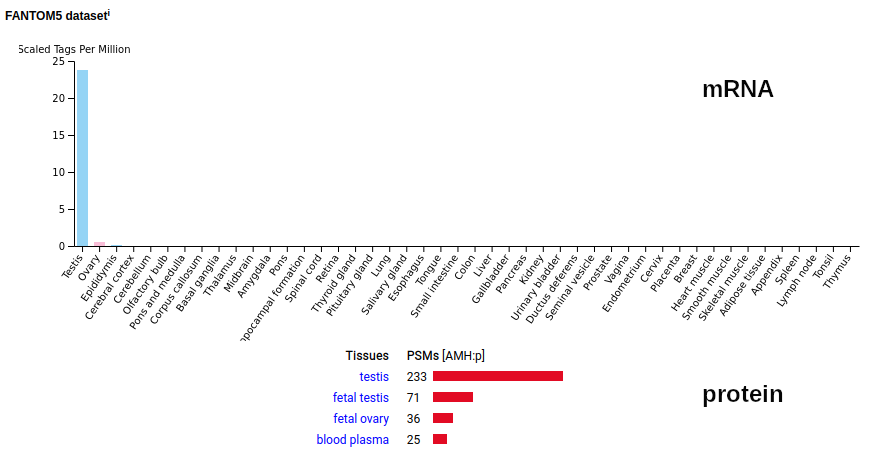
KNG1:p (kininogen 1) is an unusual proprotein alternate splicing pair (19-644)/(19-427) that contain the overlapping peptide hormones Bradykinin (381-389), Lys-bradykinin (380-389) and T-kinin (376-389). Named after the "kinin system" that was postulated originally in 1909, it's biological role still seems to be in the "group-of-blind-men-describing-an-elephant" stage of discovery. 
ASIP:p (agouti signaling protein) is a small proprotein (23-132) where the whole sequence is believed to act as a hormone. Its tissue distribution in humans suggests some activity in addition to influencing hair coloration patterning. 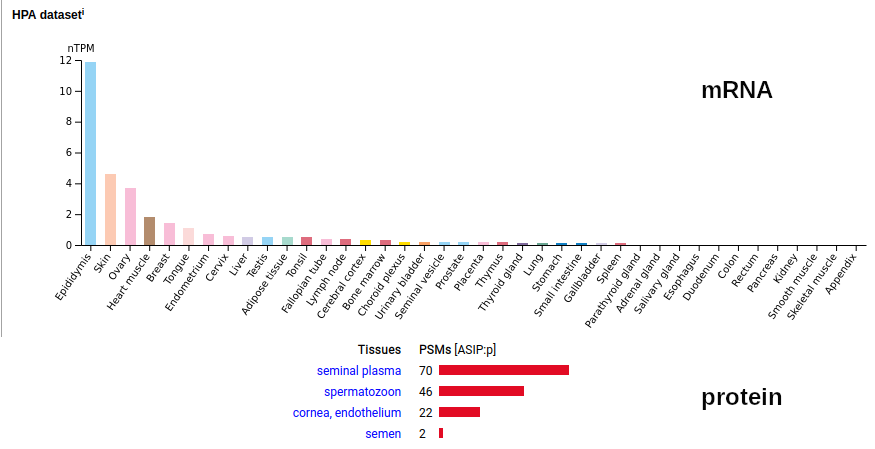
AGRP:p (agouti related neuropeptide) is a ha'penny protein (21-132) that can loose an nward remnant peptide to form the eponymous hormone (83-132). The observed localization of the protein does not match the 'zine/database banter about what this protein is all about. 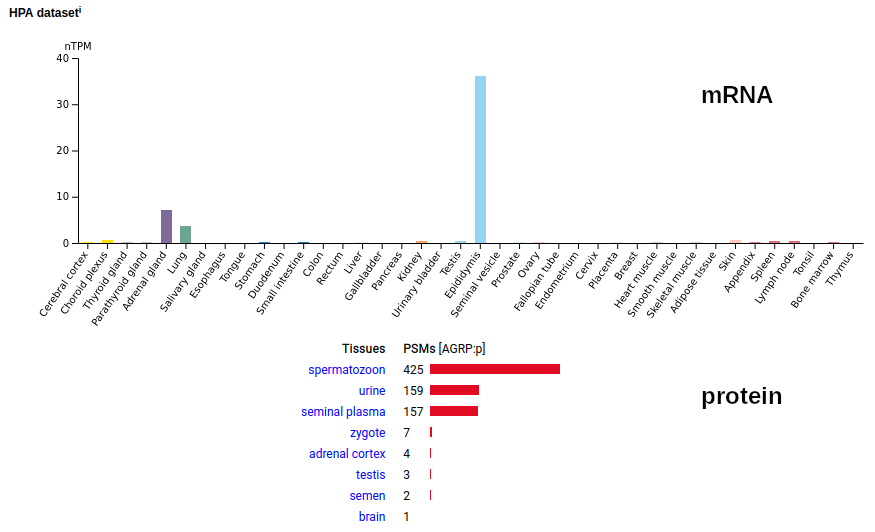
It may be of interest that the mouse tissue distribution is congruent with what you might expect from the 'zine discussion. 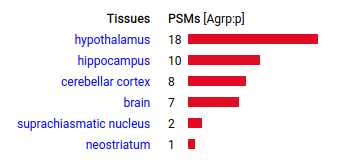
GALP:p (galanin like peptide) is a micro proprotein (25-116) that contains the putative eponymous hormone (25-84). The only rub is that it seems to be below the level of detection for both mRNA and protein measurement methods in all sampled tissues, with the exception of some melanoma samples in which the hormone shows up convincingly. 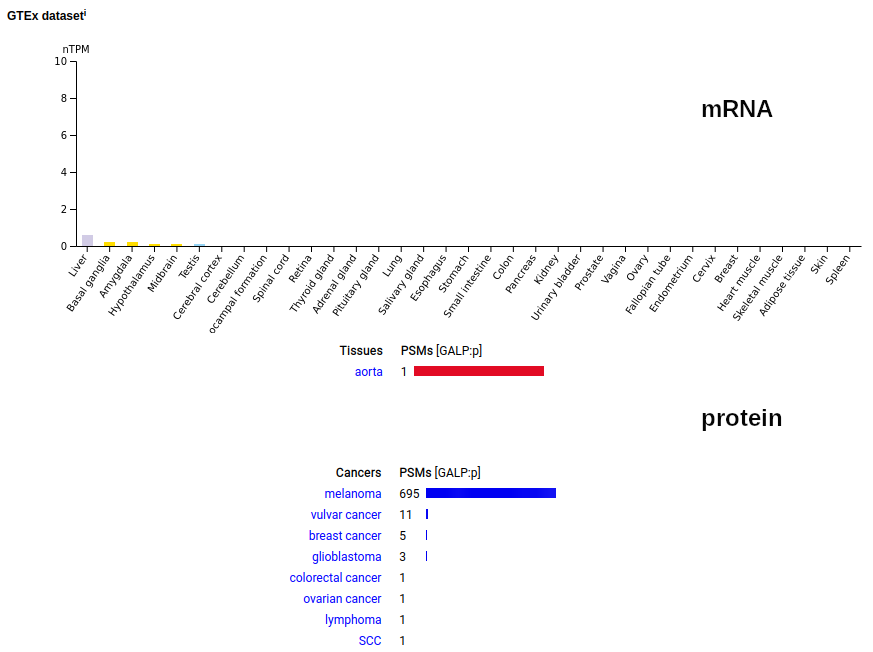
GAL:p (galanin and GMAP prepropeptide) is a dinky little proprotein (20-123) that contains the sequence for the peptide hormones Galanin (33-62) & Galanin message-associated peptide (65-123). While its CNS source is mainly the pituitary gland, the peptide was originally detected in the GI tract & associated with its effect on smooth muscle. 
PCSK1N:p (proprotein convertase subtilisin/kexin type 1 inhibitor) is on the large side for a peptide proprotein (34-260) that contains a cornucopia of peptides with nameable biological activity: KEP (34-40), Big SAAS (34-59), Little SAAS (42-59), PEN (221-242), Big PEN-LEN (221-260), Little LEN (245-254) & Big LEN (245-260). May be involved in lots of things, but how & why so much of it ends up in urine is unclear. 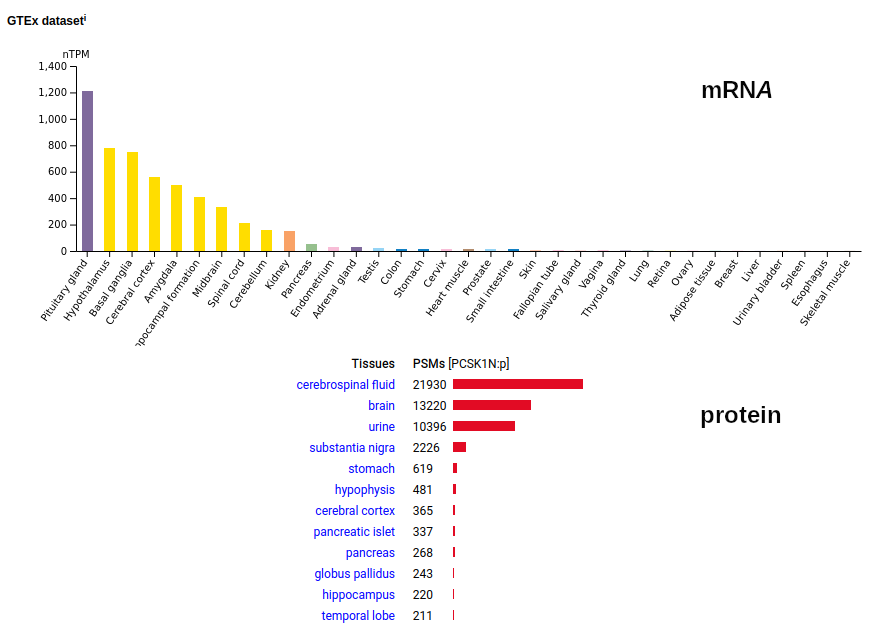
PNOC:p (prepronociceptin) is a midget proprotein (20-176) that contains the sequences of several named peptide hormones: Nocistatin (98-127), Nociceptin (130-146) & Orphanin FQ2 (149-165). While discussion of the role of these hormones centres on the central nervous system and opioid receptors, the presence of proprotein mRNA in lymphatic tissue remains to be addressed. 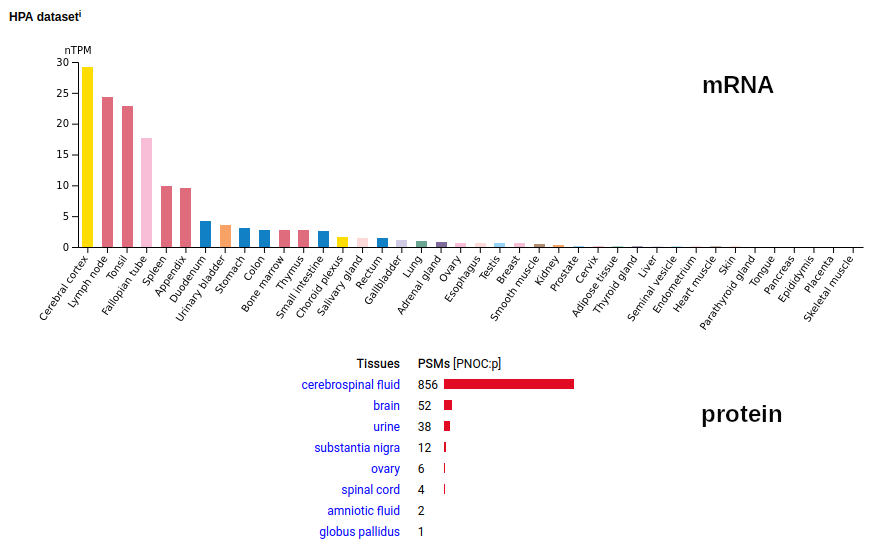
ADCYAP1:p (adenylate cyclase activating polypeptide 1) is an easily ignored little proprotein (25-176) that contains several generically named peptide hormones (81-128), (131-157) & (131-168) as well as an inactive remnant peptide (25-78). These products are dumped into the cerebrospinal fluid in the brain, where the remnant peptide dominates proteomics observations. All of the proprotein shows up in the relatively rare pancreatic islet observations. 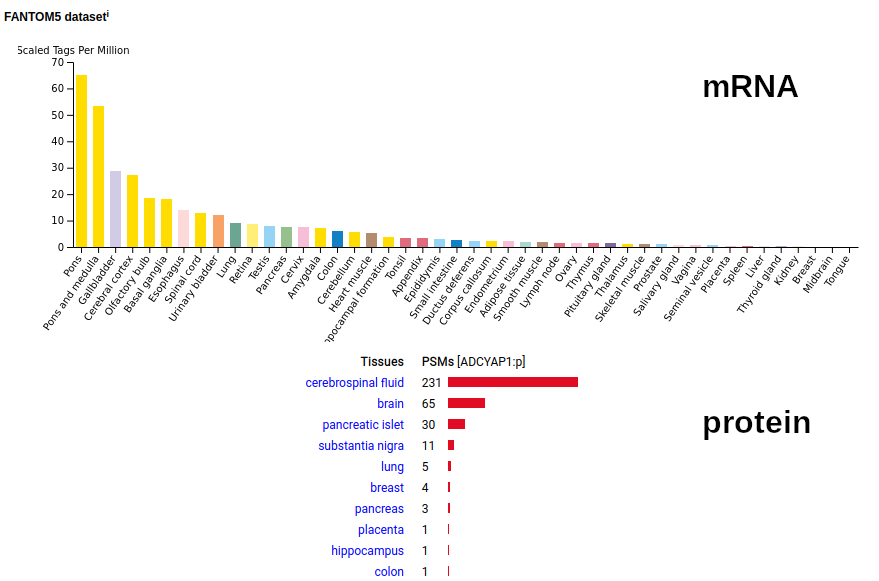
CARTPT:p (cocaine and amphetamine regulated transcript propeptide) is a tiddly little proprotein (28-116) that contains several CART-named peptide hormones (e.g., 28-66 & 69-116). While it sounds like it was discovered during an exciting undercover investigation involving Sonny Crocket & Walter White, this proprotein is normally secreted by the hypothalamus into the cerebrospinal fluid & may be expressed ectopically in some breast cancers. 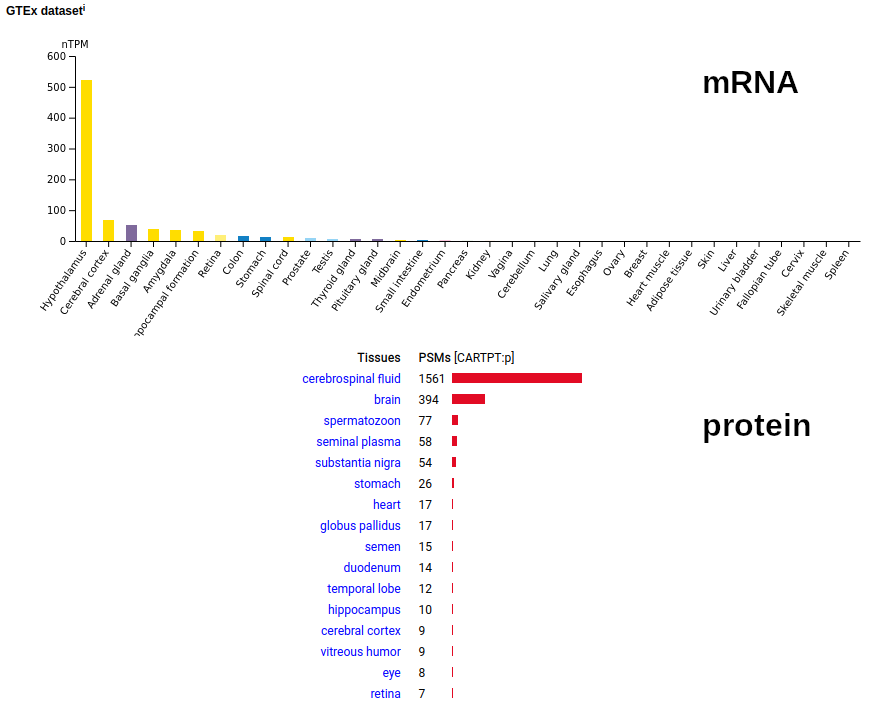
CSH1:p (chorionic somatomammotropin hormone 1) is a smallish human proprotein (27-217) that has growth hormone activity & it is secreted by the placenta. It is nearly identical to CSH2:p & has significant homology (& signal crosstalk) with CSHL1:p, GH1:p & GH2:p. While this little clutch of hormones is shared by most primates, many mammals "get by" using GH1:p only. 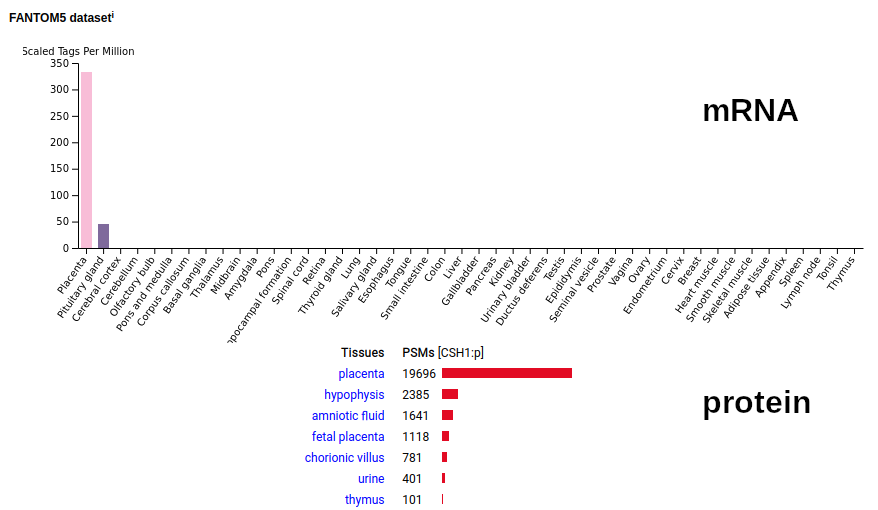
OSTN:p (osteocrin) is a micro proprotein (28-133) that may be a peptide hormone as is, or following some processing (83-132). Human mRNA signals are at very low levels scattered around various tissues and the protein observations are limited to the intact proprotein in urine and CSF. 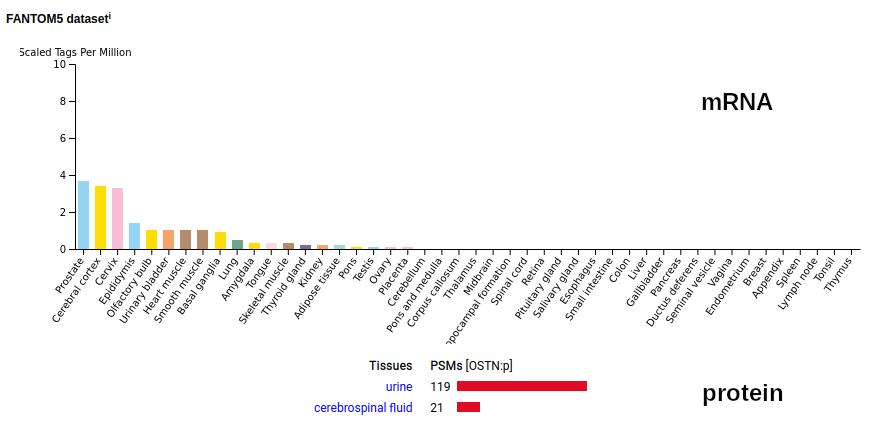
The protein observations of OSTN:p in mice may explain the protein's alternate name: musclin. 
Just in case you are wondering where the "osteo" part of the name came from (normally reserved for bone-related things), as far as I can tell the following study is the source of the moniker: RLN1:p (relaxin 1) is a small proprotein (23-185) containing an A-chain (163-185), B-chain (23-53) & C-peptide (56-158). It is presumably secreted in the testes at low levels, just peaking its head above the LOD for proteomics experiments. You would be wise to take the 'zines/database view on relaxin function and localization with considerable skepticism. 
INSL6:p (insulin like 6) is a little overweight for a proprotein (21-213), containing an A-chain (173-198), B-chain (21-53) and C-peptide (55-168) for the named hormone. Peptides from all three named peptide domains are observable in spermatozoa. Function: your guess is as good as anyone's. 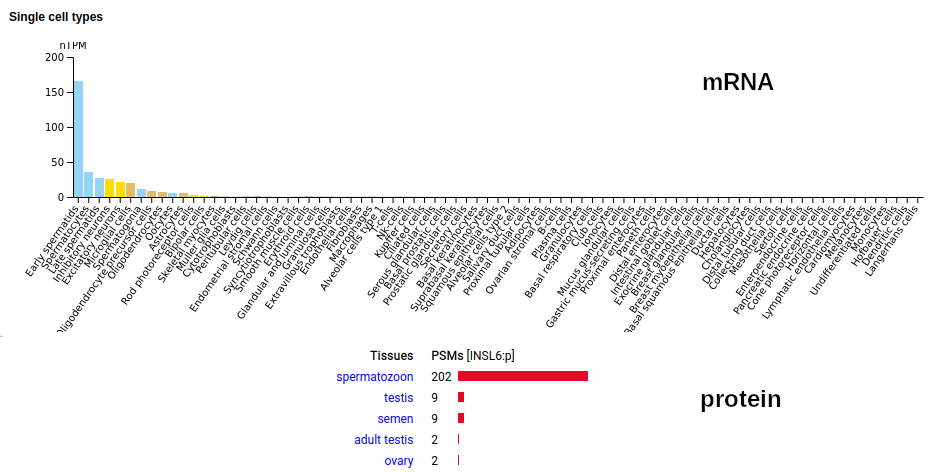
INSL5:p (insulin like 5) is an insulin-sized proprotein (23-135) that contains an A-chain (115-135), B-chain (23-46) & C peptide (49-114) that is fabricated and secreted by the large intestine, although a function associated with this little guy is still for future generations to discover (or more likely ignore). 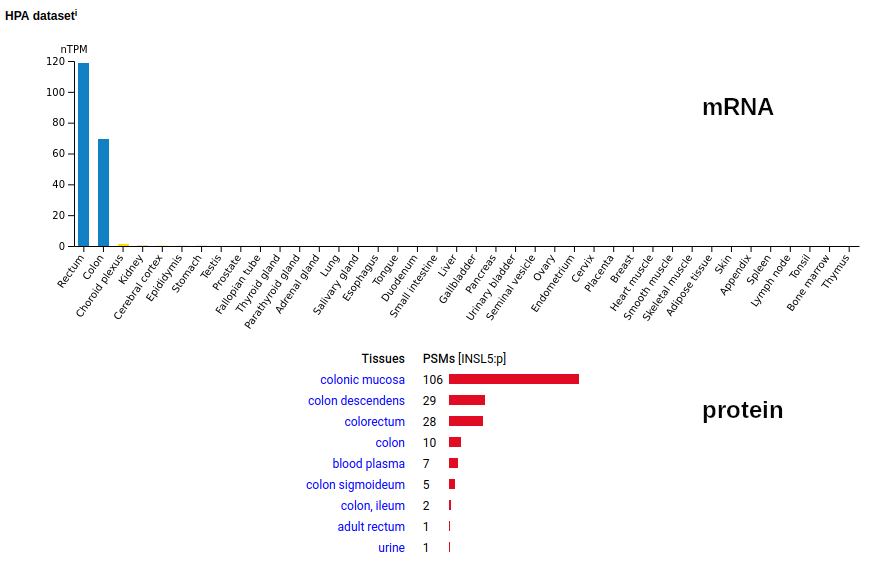
For the mouse model crowd, it would appear that mice may be using (or at least making) INSL5:p in a similar way to humans, so your favourite platform may turn out to be useful in this case. 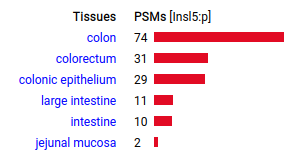
INSL4:p (insulin like 4) is a suitably small proprotein (25-139) that contains the sequence for an A-chain (115-139), B-chain (26-58) & a C-peptide (59-114). It is secreted by endocrine cells in the placenta, although why this occurs is still pretty mysterious. 
INSL3:p (insulin like 3) is a wisp of a proprotein (21-131) that contains the sequence for the titular peptide hormone's A-chain (106-131) & B-chain (21-55), with the sort of C-peptide (58-104) that any decent insulin-ish proprotein should have. All three named peptide regions are observable in testicular or ovarian follicular tissue samples, but no where else. 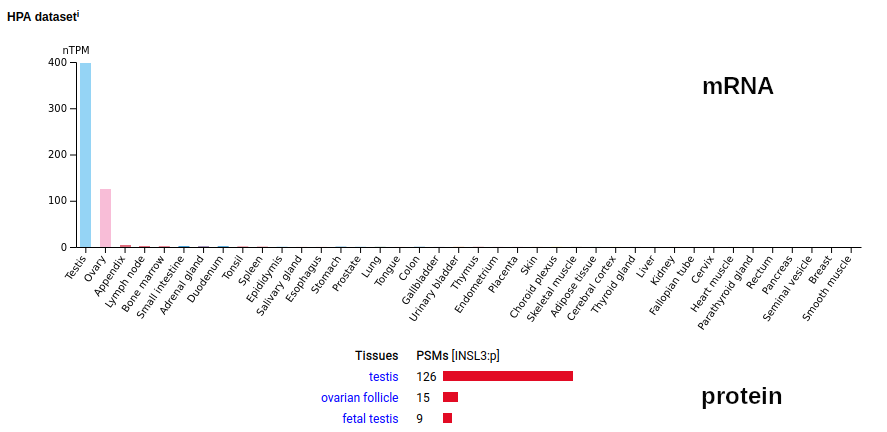
IGF2:p (insulin like growth factor 2) is also a little on the long side for a proprotein (25-180), with its eponymous peptide hormone portion (25-91) requiring the removal of only a cward remnant. Most of the proprotein ends up being observable in blood plasma, cerebrospinal fluid, urine & amniotic fluid, including the full peptide hormone sequence. The blood serum concentration of IGF2 is normally about 700 ng/ml. 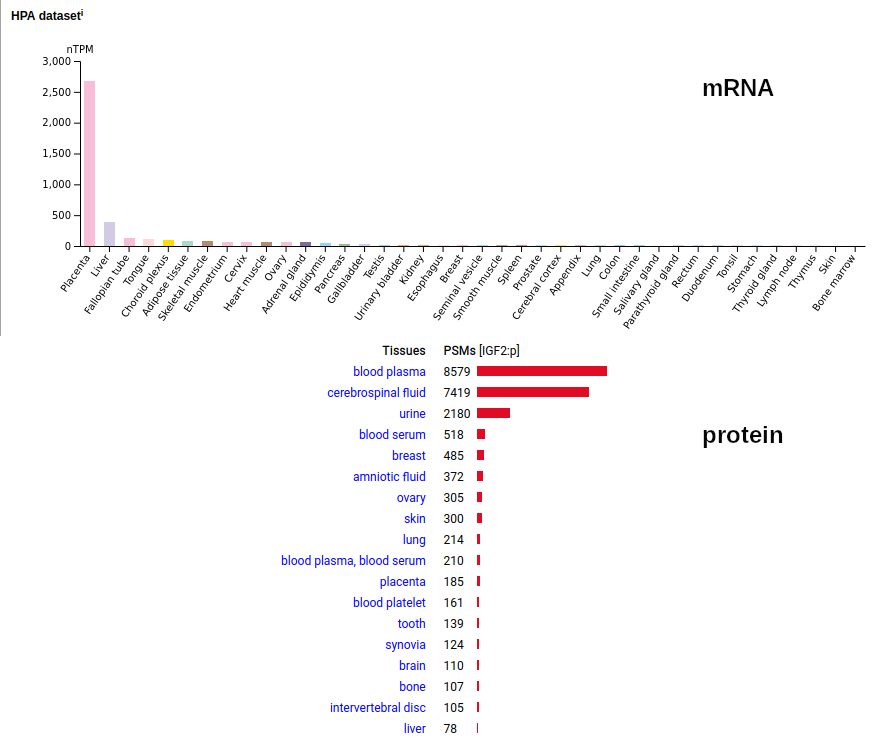
IGF1:p (insulin like growth factor 1) is a little on the long side for a proprotein (21-195), with its eponymous peptide hormone portion (49-118) requiring the removal of nward and cward remnants. Unusually for a proprotein, the peptide hormone itself is the most commonly observed entity in proteomics experiments in samples that contain blood plasma. Its observed absence in urine seems a little odd. 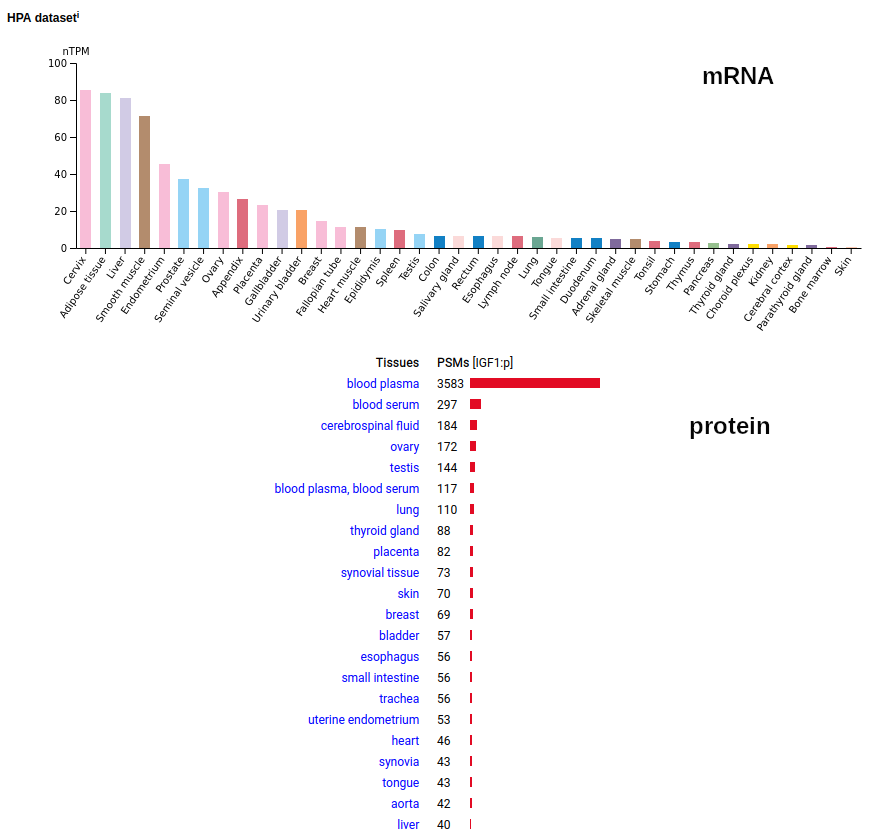
PYY:p (peptide YY) is a tiny proprotein (29-97) produced mainly in the gut that contains the sequence of its namesake hormone (29-64). It slows down the secretion of pancreatic digestive enzymes, reduces gastric motility & increases water and salt absorption by the colon. 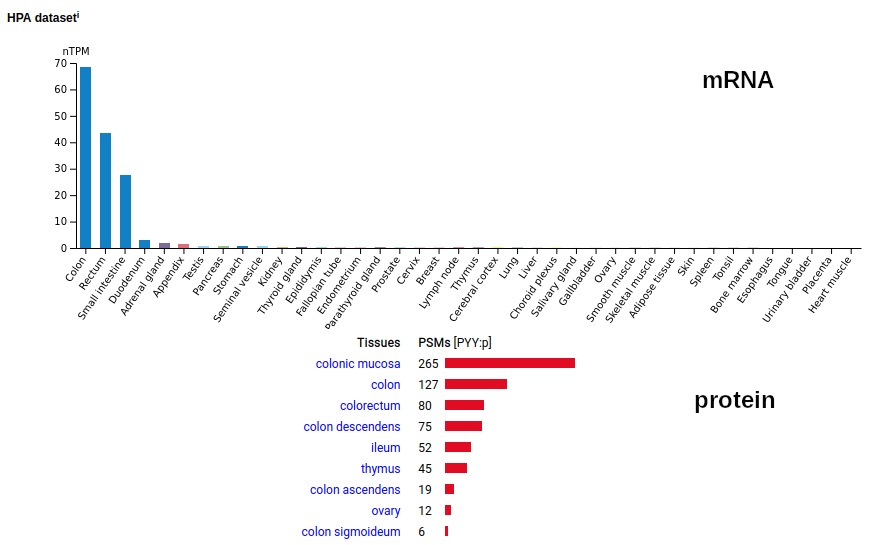
The "Y" in the names of the peptide hormones 'pancreatic peptide Y', 'neuropeptide Y' and 'peptide YY' mean that the sequences contain tyrosine. Deliberate obscurantism really shines through in HGNC's approach to peptide hormone proprotein naming. NPY:p (neuropeptide Y) is a very small proprotein (29-97) that contains the sequence for is eponymic peptide hormone (29-64). When observed, peptides from both the hormone & remnant peptide are prominent. Despite the name, it may be observed outside of the CNS, e.g., prostate or heart tissue. 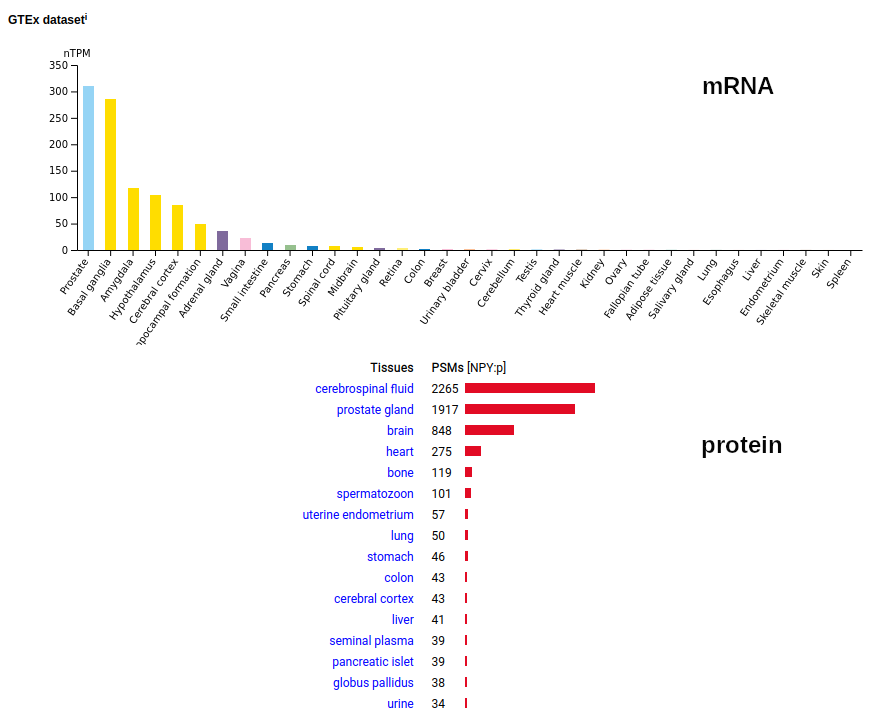
PTH:p (parathyroid hormone) is an itsy-bitsy proprotein (25-115) which isn't much more than a tweak more than its namesake peptide hormone (32-115). The parathyroid in humans is pretty intimately associated with the esophogus, behind the thyroid gland. Unlike many peptide hormones in which proteomics detects inert chunks of sequence left over from making the hormone, only the intact hormone is detected here. 
HAMP:p (hepcidin antimicrobial peptide) is a pygmy proprotein (25-84) that contains the sequence for the peptide hormone Hepcidin (60-84). The inactive nward portions of the proprotein are easily detectable in urine, as is the hormone & multiple inactivated hormone metabolites, e.g, (65-84), (66-84), (67-84), (68-84) & (69-84). 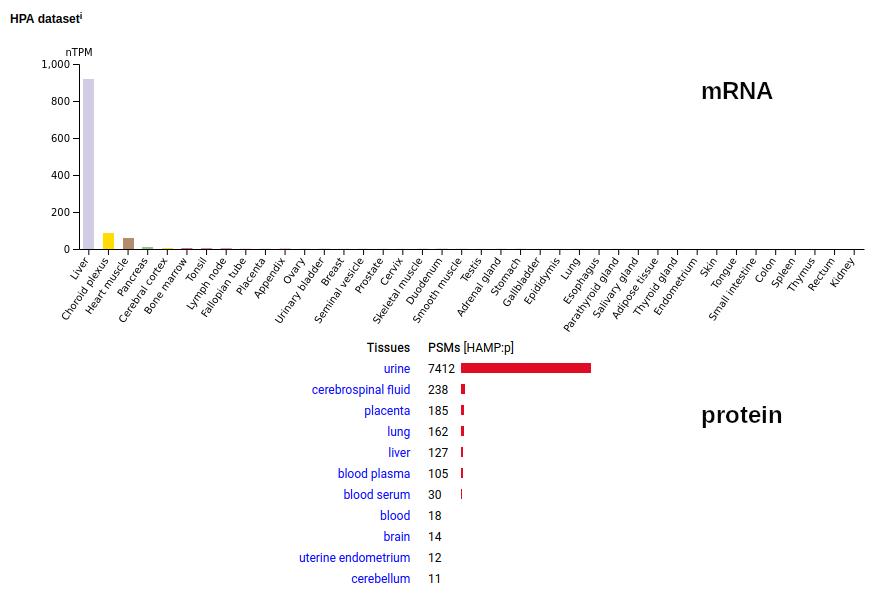
PTHLH:p (parathyroid hormone like hormone) is a piddly little proprotein (37-177) that contains several sequences that have been declared hormones in the 'zines: PTHrP[1-36] (37-72); PTHrP[38-94](74-130); & Osteostatin (143-175). While its involvement in mammary gland differentiation is mentioned in the blurbs, the fact that it is the most frequently observed hormone proprotein in human milk may surprise some. 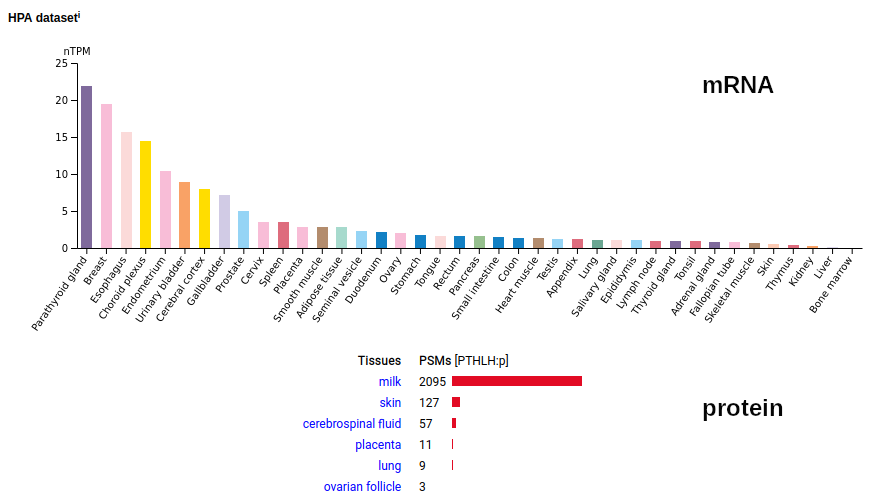
ECRG4:p (ECRG4 augurin precursor) is a small proprotein (32-148) that contains the sequence for the 52 residue peptide hormone Augurin (71-132). The role of the hormone in the brain is a little foggy & its presence in bone seems to be enhanced in some tumours, e.g. chordoma. 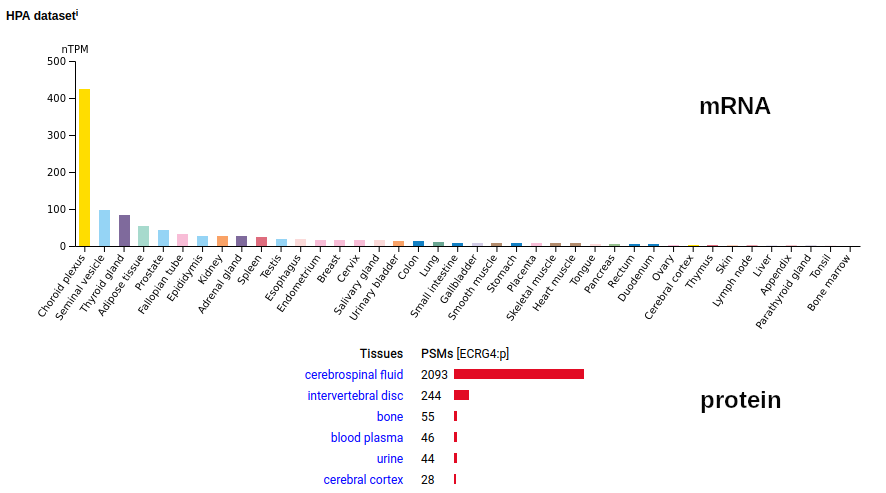
CORT:p (cortistatin) is a midget proprotein (21-105) that contains the sequence for its patronymic peptide hormone cortistatin-17 (89-105). Made in the brain, secreted into the cerebrospinal fluid, cortistatin binds to somatotropin receptors & is apparently involved in maintaining sleep. 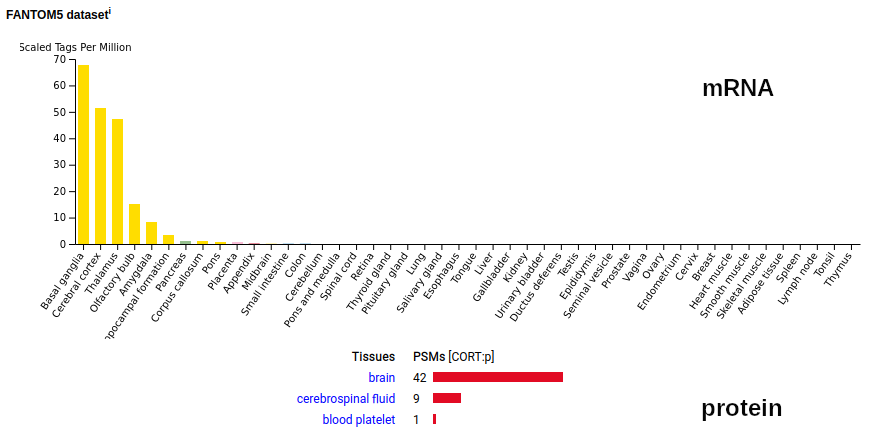
TRH:p (thyrotropin releasing hormone) is a small proprotein (25-242) the contains multiple copies of its namesake tripeptide hormone QHP: (84-86), (114-116), (135-137), (152-154), (186-188) & (227-229). The propeptide (or remnants) tends to be observed in fluids. Why it is being made in the eye is still seems to be anybody's guess. It also shows up unexpectedly in some cancers, e.g., breast cancer, glioma & uterine corpus endometrial carcinoma. 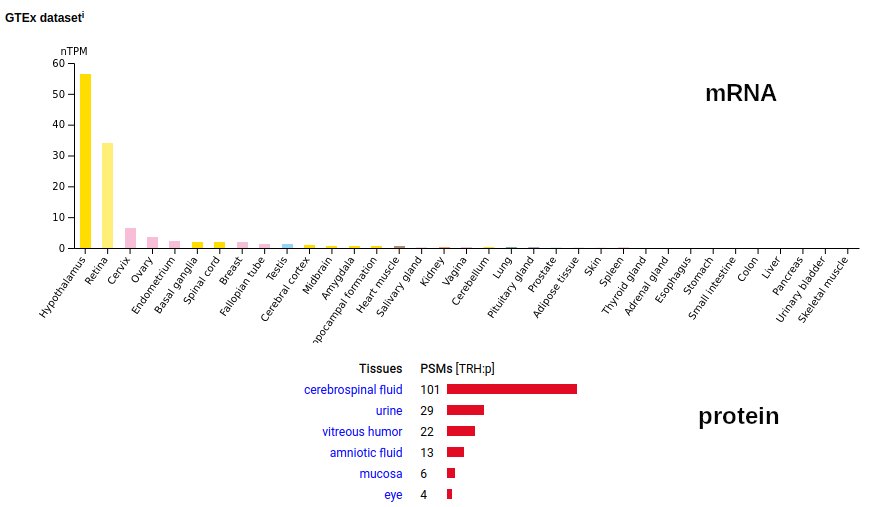
CRH:p (corticotropin releasing hormone) is chunky little proprotein (25-196) that contains the peptide sequence for corticotropin-releasing hormone (154-194, aka corticoliberin). When secreted in the brain, it causes the release of ACTH; when secreted by the placenta (primates-only) it has been associated with lots of possible things, but without any clear indication why primates would need to use it (in quantity) when other creatures do not. 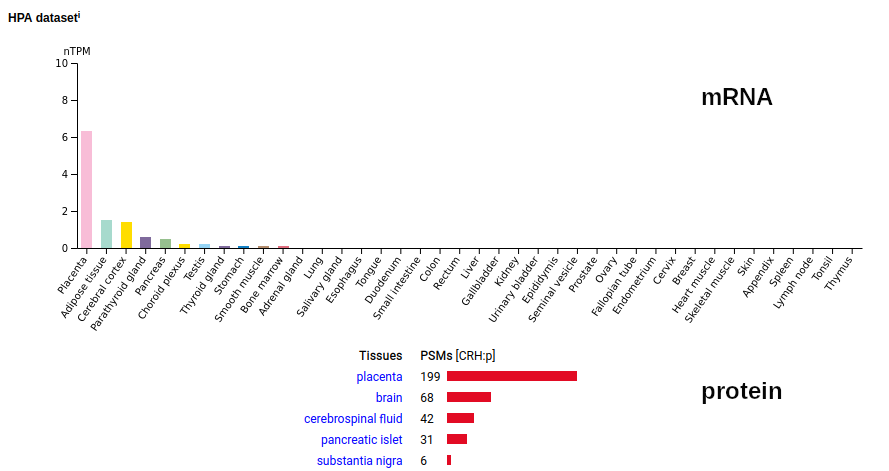
NTS:p (neurotensin) is slight, paltry little proprotein (24-164) that contains the sequence for its namesake peptide hormone neurotensin (151-163). This hormone is made in the brain & intestines, with very different consequences. There are several other named peptides associated with this sequence. 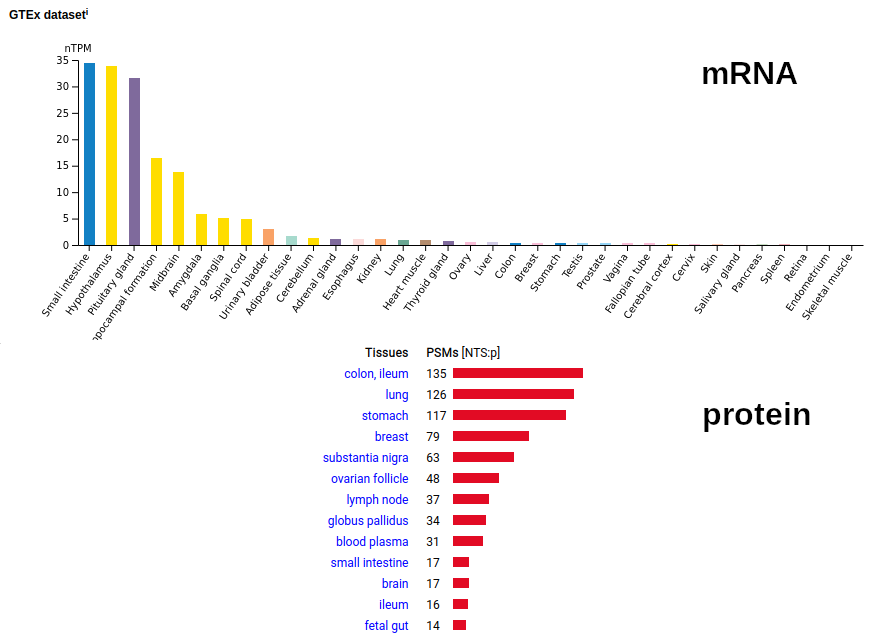
MLN:p (motilin) is a very small proprotein (26-115) made by endocrine cells in the duodenum & small intestine. It contains the sequence of the peptide hormone motlin (26-47) and the inert motilin-related peptide (50-115) that are secreted into the blood, regulating small intestine contractions. Observations in urine are due to motilin-related peptide. MLN and/or its receptor (MLNR:p) are pseudogenes in rodents. 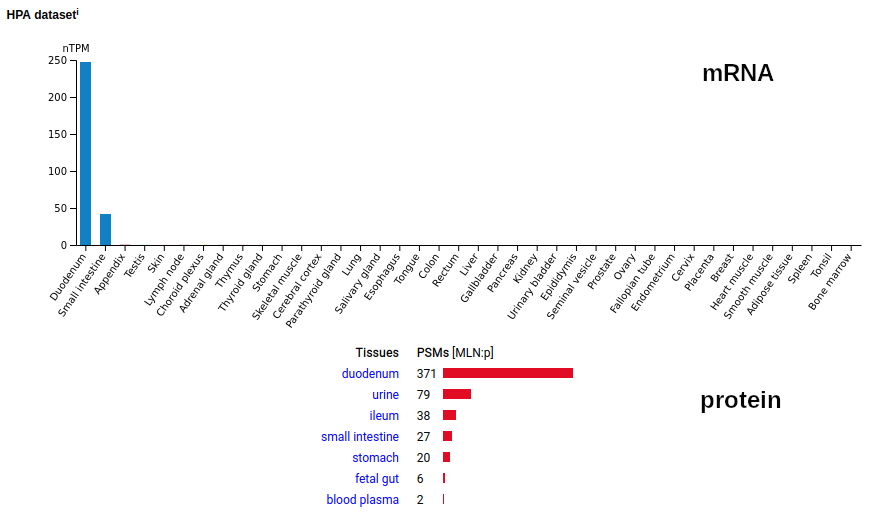
NPPC:p (natriuretic peptide C) is a small proprotein (26-126) that contains the sequence of the peptide hormone C-Type Natriuretic Peptide 22 (105-126, CNP). The N-terminal portion of the sequence that is removed to form the hormone builds up to observable levels in cerebrospinal fluid. 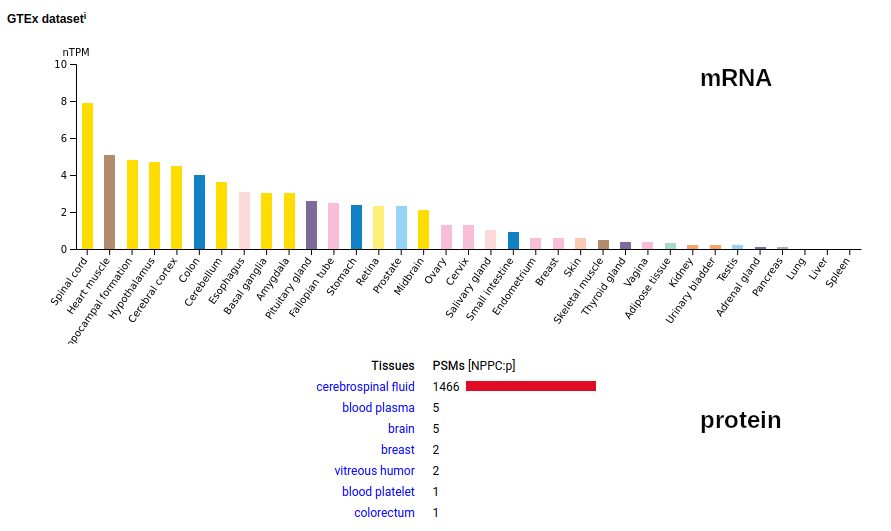
NPPB:p (natriuretic peptide B) is a small proprotein (27-134) that contains the sequence of the peptide hormone Brain Natriuretic Peptide 32 (103-134, BNP). It is secreted by cardiomyocytes to lower blood pressure using the same set of receptors as Atrial NP. The proprotein N-terminus is ragged, beginning anywhere from A27 to V33. While it may seem odd that a hormone secreted by the heart has "Brain" in its name, it isn't: many protein-related names end up being a bit ironic. 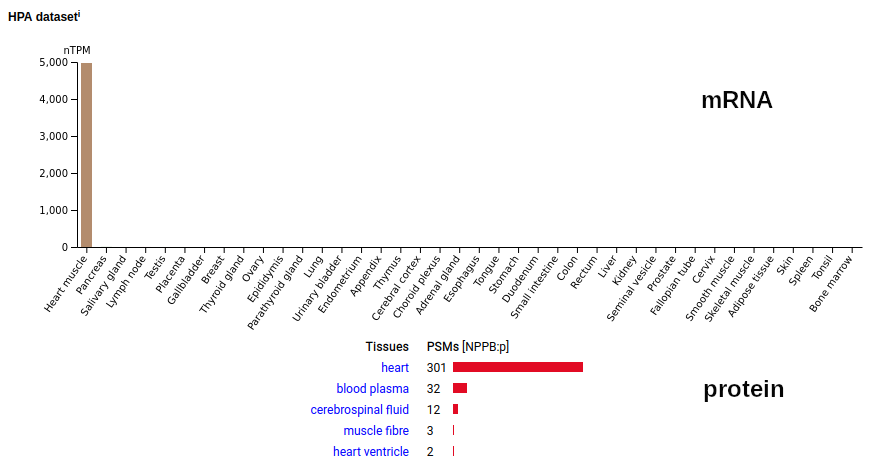
NPPA:p (natriuretic peptide A) is a small proprotein (26-151) that contains the sequence of its namesake peptide hormone Atrial Natriuretic Peptide (124-151, ANP). Secreted by cardiomyocytes to lower blood pressure: causes vasodilation as well as increasing renal excretion of salt & water. The N-terminus is unusually ragged, beginning anywhere from A25 to V32. It contains 10 other named peptides. The intact proprotein is observed in proteomics experiments, not the hormone(s). 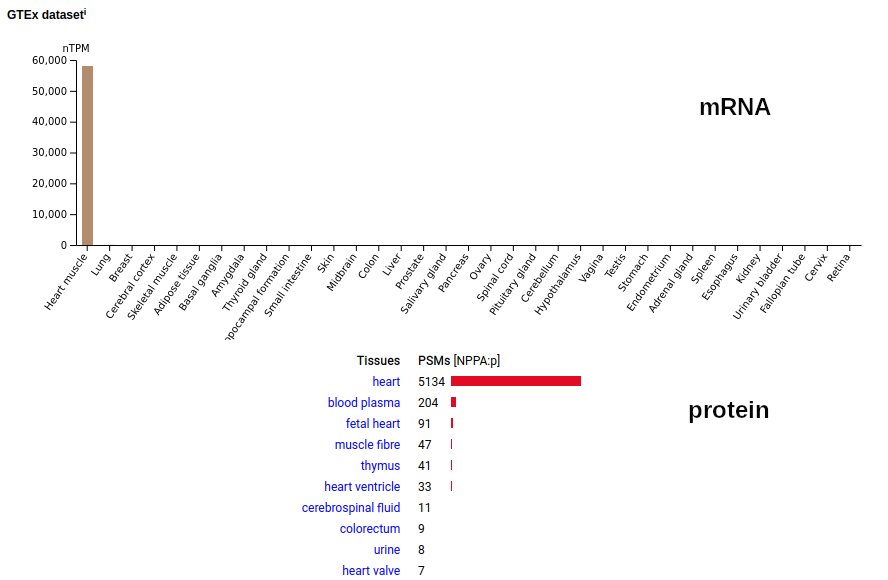
EDN3:p (endothelin 3) is a small proprotein (19-238) that contains the vasoconstriction hormone endothelin 3 (97-117). Regardless of where it is translated, both the peptide remnants (19-96) & (118-238) may be detected in proteomics experiments, but never the hormone itself. 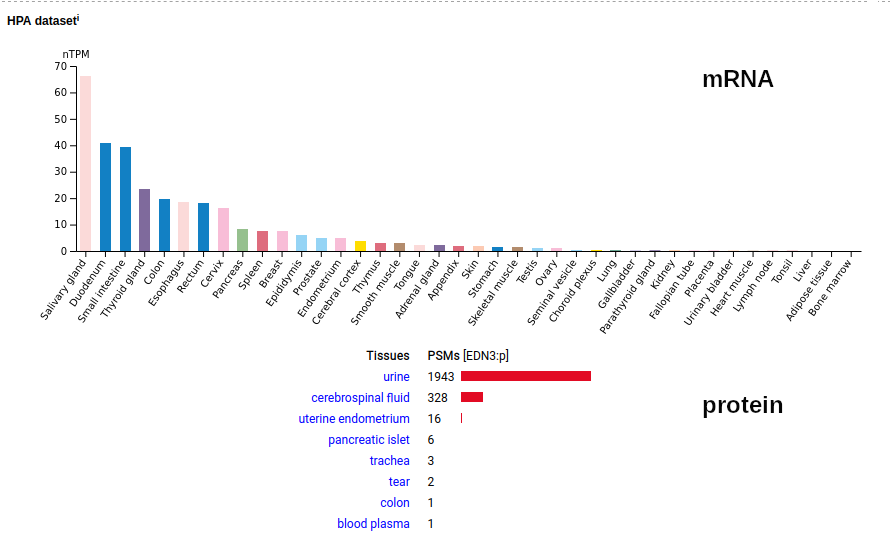
EDN2 (endothelin 2) is the second small proprotein (19-178) that contains a version of the cysteine-rich vasoconstrictor endothelin (49-69). As is frequently the case for hormone proproteins, the peptide hormone itself is not normally observed in proteomics experiments. Instead, observing the C-terminal remnant cut off to form the hormone (70-178) can be used as a surrogate. 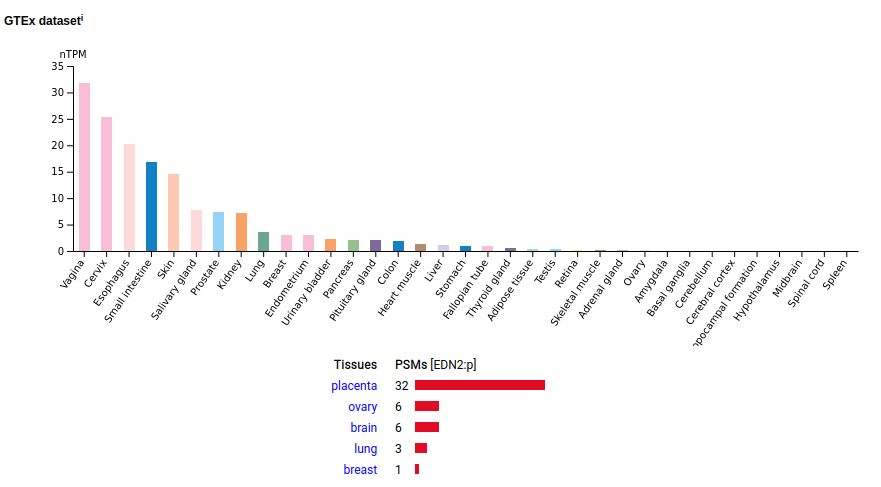
EDN1:p (endothelin 1) is a small proprotein (18-212) that contains the vasoconstrictor hormone endothelin-1 (53-73). It is produced by vascular endothelium, which is present to some extent in many tissues. The hormone itself is never observed: instead the intact C-terminal remnant (74-212) can be used as a surrogate. 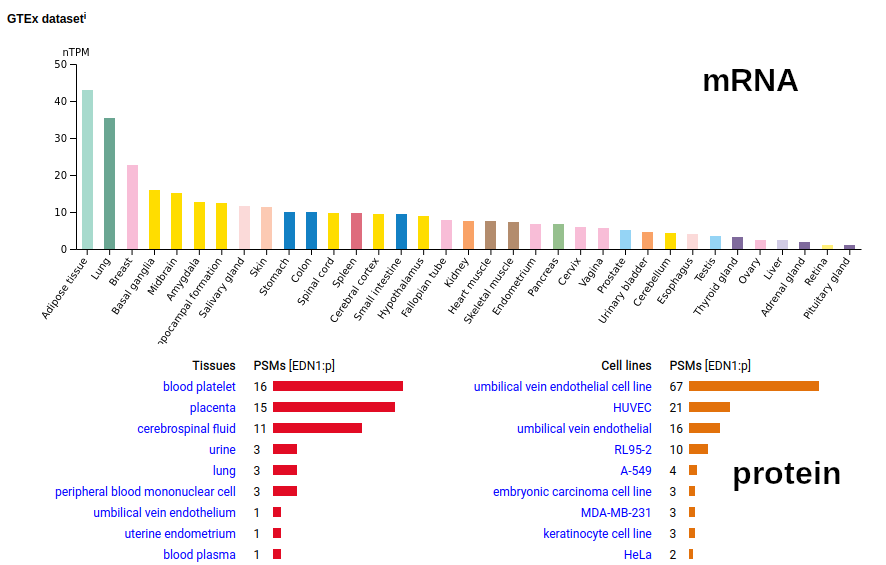
ENHO:p (energy homeostasis associated) is a itsy-bitsy protein (34-76) that is referred to as adropin. It was originally described in mice as a metabolic hormone originating in the liver: its role in the CNS is still unclear. 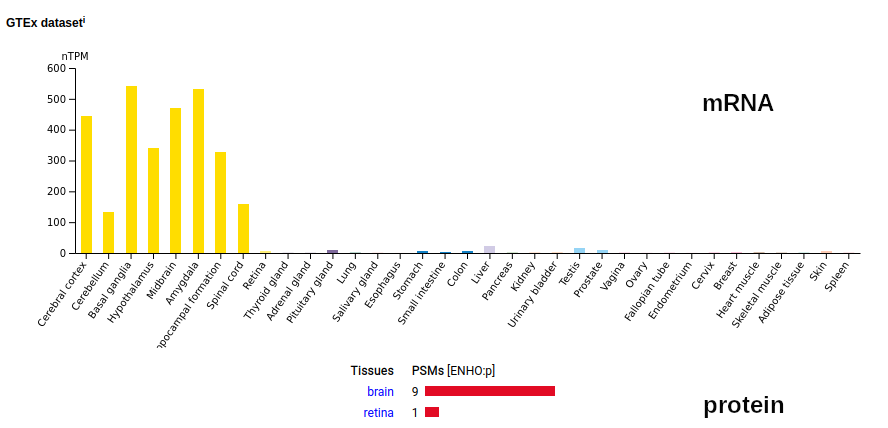
SCG5:p (secretogranin V) is the smallest protein (28-212) in the granin family of phosphoproteins. It is necessary for the proper function of PCSK2:p, one of the peptidases that selectively make peptide hormones out of the proproteins present in secretory vesicles. It is best observed in cerebrospinal fluid (where it seems to accumulate) and in tissues containing endocrine cells that use this type of vesicle. 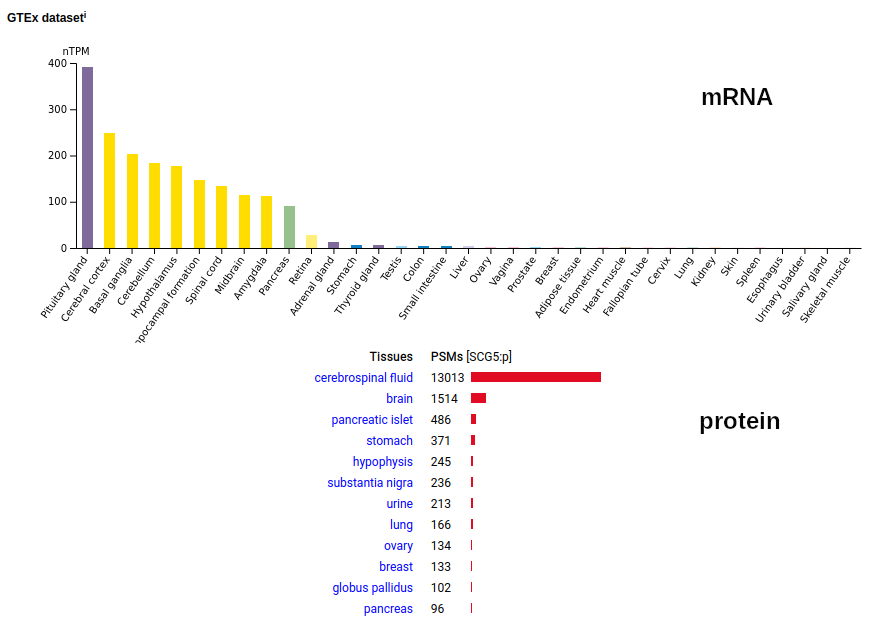
SCG3:p (secretogranin III) is a glycosylated phosphoprotein (20-468) that is part of the packaging in endocrine secretory granules, particularly in CNS neurosecretory cells. It is best observed in cerebrospinal fluid, where it seems to accumulate. It is very rarely detectable in urine. If there are peptide hormones hiding in its sequence, no one has found them yet. 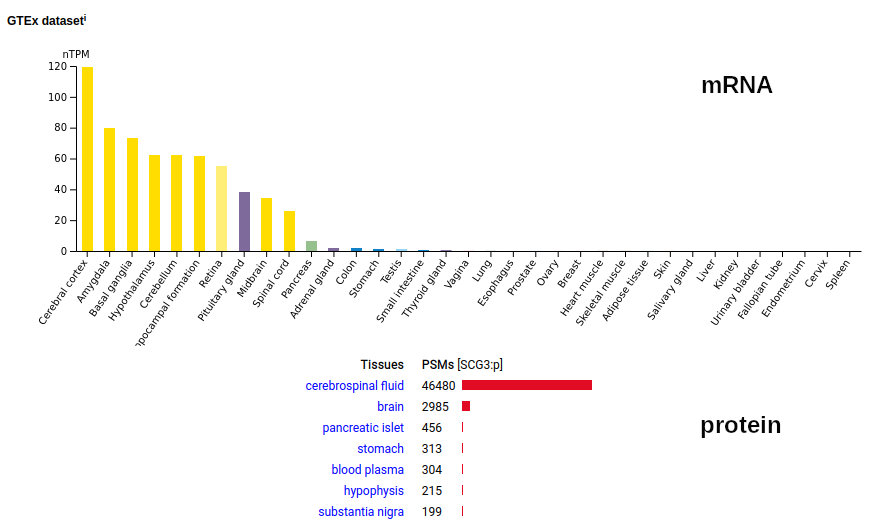
SCG2:p (secretogranin II) is a secreted phosphorylated glycoprotein (28-617) that is easily observed in cerebrospinal fluid and to a lesser extent in endrocrine cells from many tissues. It is an essential component of neuroendocrine cell secretory granules & is the source for the neuropeptides secretoneurin (182-214) & manserin (527-566). 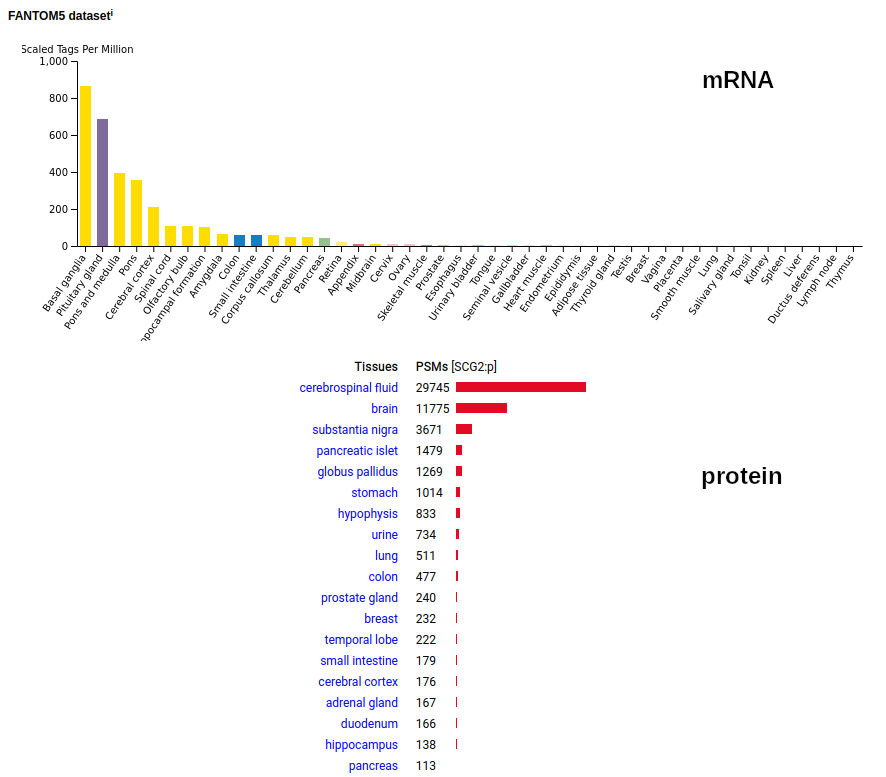
CHGB:p (chromogranin B) is another midsized protein (21-677) that is necessary for the proper formation of secretory vesicles, particular in neuroendocrine cells. The intact protein is most frequently observed in CSF and tissue containing endocrine cells, although like CHGA:p, intact protein can be observed in urinary extracellular vesicles. It is believed to be cleaved to produce active peptides: the jury is still out on this process. 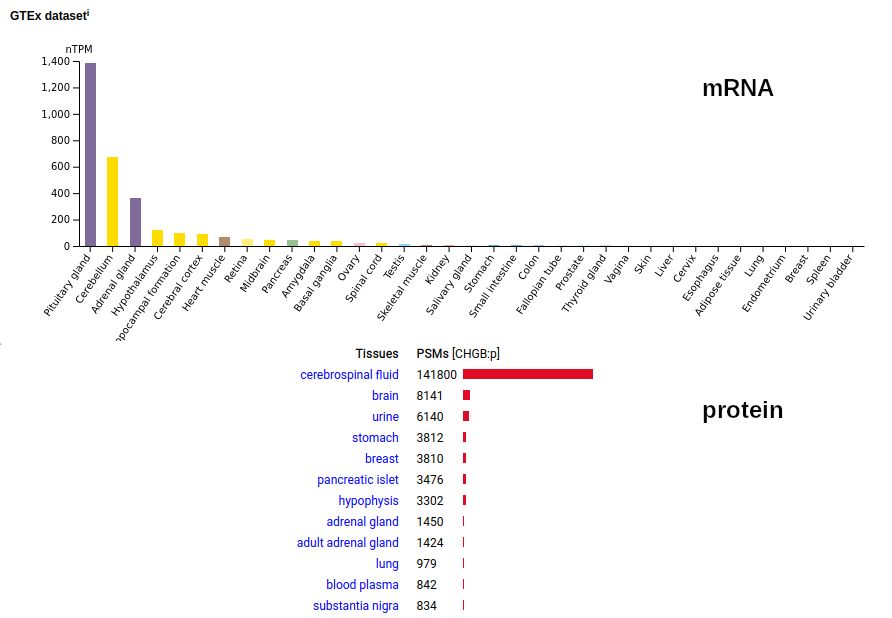
CHGA:p (chromogranin A) is a proprotein (19-447) that is involved in the formation & maintenance of secretory vesicles in endocrine cells. It is secreted from these vesicles mainly into CSF & blood plasma. It is also the source of a surprisingly varied array of biologically active peptide hormones, e.g. Vasostatin-1 (19-94); 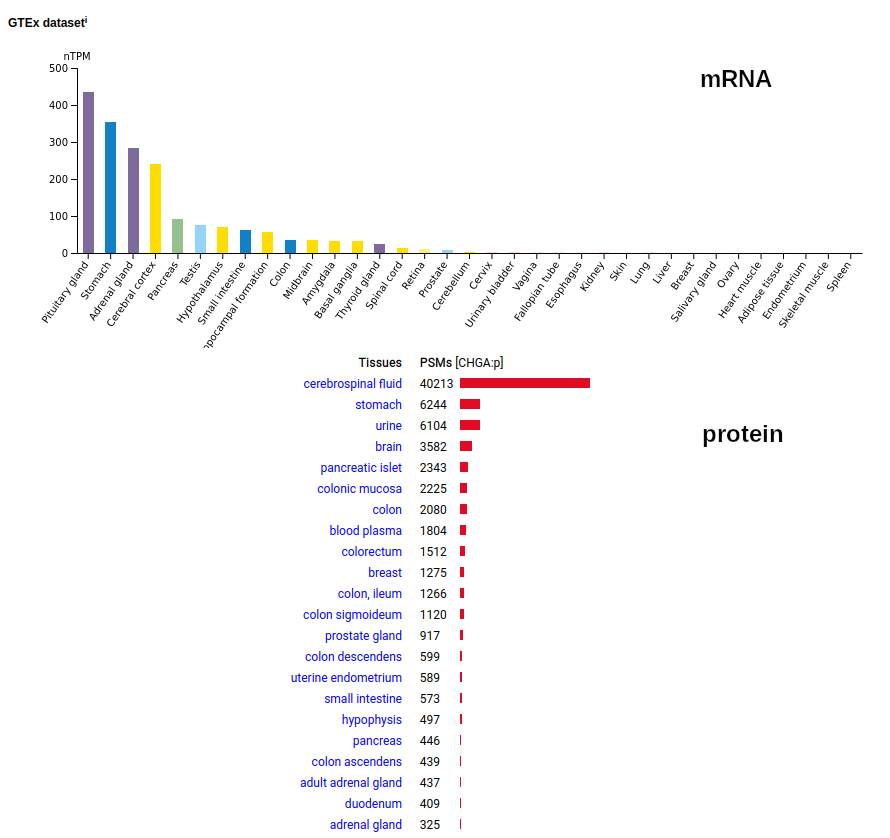
CBLN1:p (cerebellin 1 precursor) makes a small, secreted proprotein (25-193) that may be somehow involved in the formation & maintenance of CNS synapses. It also contains a peptide hormone, cerebellin (57, 58-72). that can effect neurotransmitter secretion. What it is doing outside of the brain―e.g. blood plasma or testis/spermatozoa―is anybody's guess at the moment. 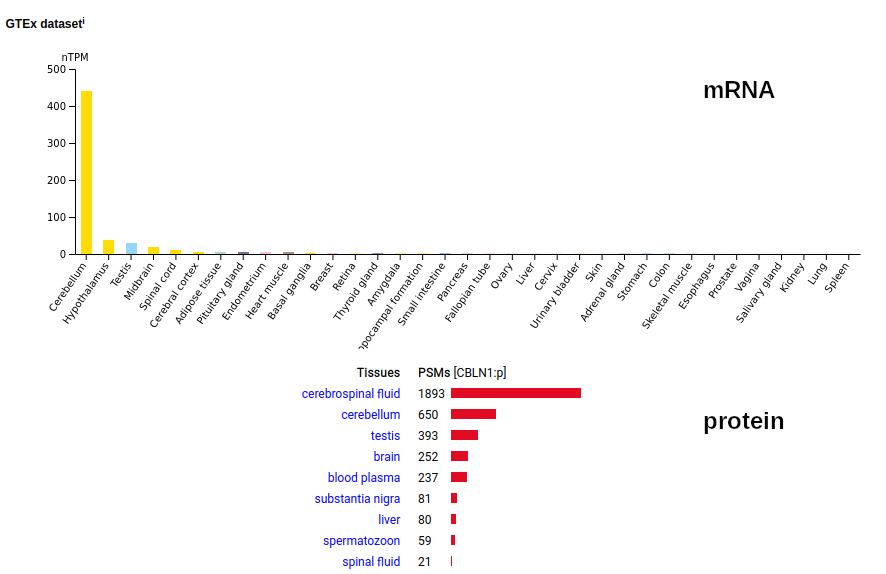
ADM:p (adrenomedullin) makes a small proprotein (22,23-185) that is cleaved to for its namesake peptide hormone (95-146). While it seems to be made all over the place, it is most easily detected via its remnant peptides in CSF and urine. 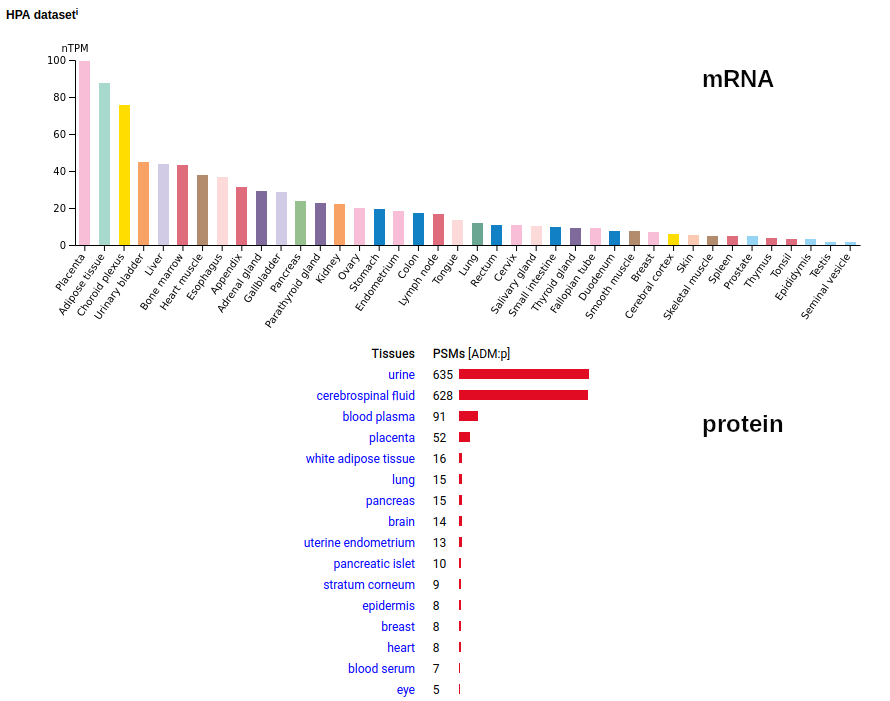
SMIM20:p (small integral membrane protein 20) is a very small mitochondrial intermembrane protein (1,2-67) that is observed in MHC peptide experiments in many tissues. It is the source of phoenixin (45, 51-64), a peptide hormone that seems to be involved in too many biological processes. 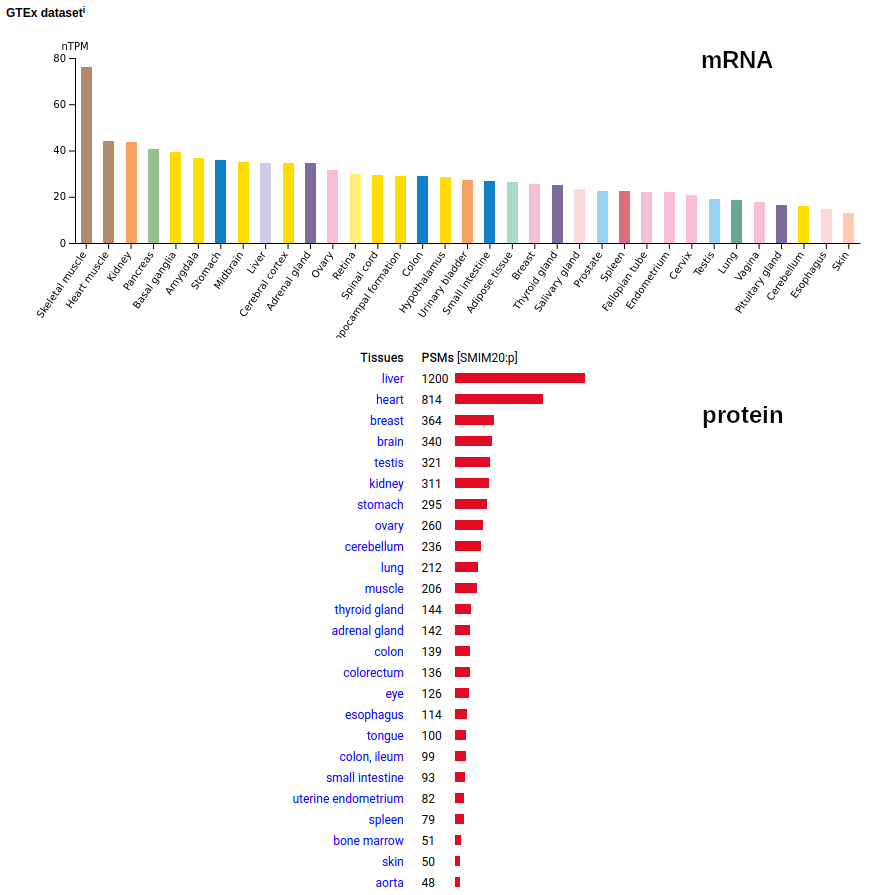
KISS1:p (KiSS-1 metastasis suppressor) makes a puny proprotein (20-138), mainly in the placenta. Maybe it has something to do with preventing metastasis & maybe it makes some peptides that served as a hormone that can stimulate the release gonadotropin releasing hormone (108,109,112-121). Astonishingly dumb name for a gene/protein, though. 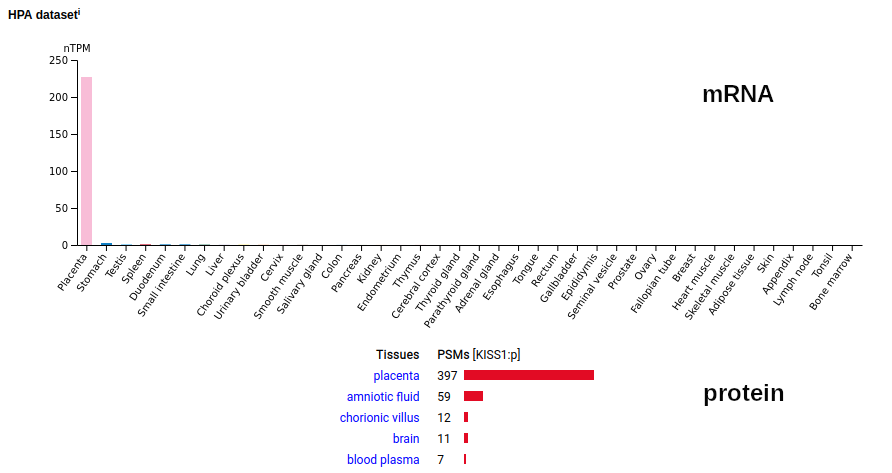
GNRH1:p (gonadotropin releasing hormone 1) is a pint-sized proprotein (24-91) that is cleaved to create its eponymous hormone (24-33). This is a hormone that stimulates the release other peptide hormones, mainly from the pituitary gland. The hormone itself hasn't been observed via proteomics experiments: only the C-terminal remnant of the proprotein appears in some "deep" CSF studies. 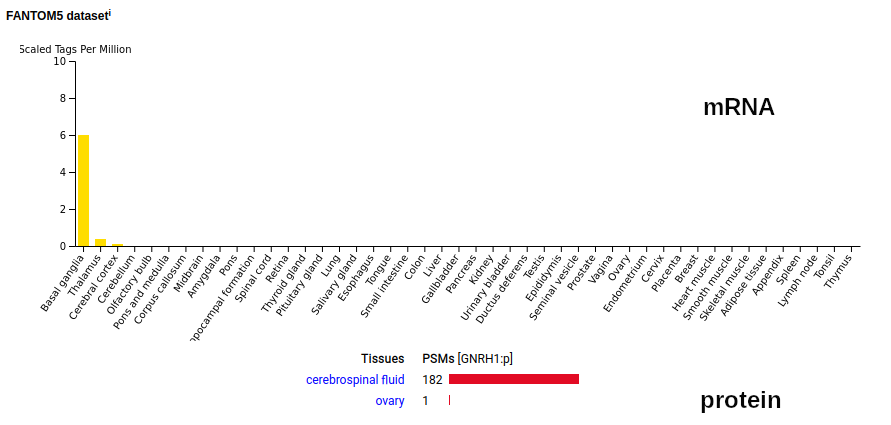
CALCA:p (calcitonin related polypeptide alpha) has a good story based on the neuropeptide model: a proprotein (26-141) is produced in thyroid C cells, where it is processed into calcitonin (85-116) & katacalcin (121-141). These peptides are released into the blood to lower circulating calcium levels. The presence of easily detectable amounts of mRNA in kidney and intact "proprotein" in urine suggests something else is going on, in parallel with the legend. 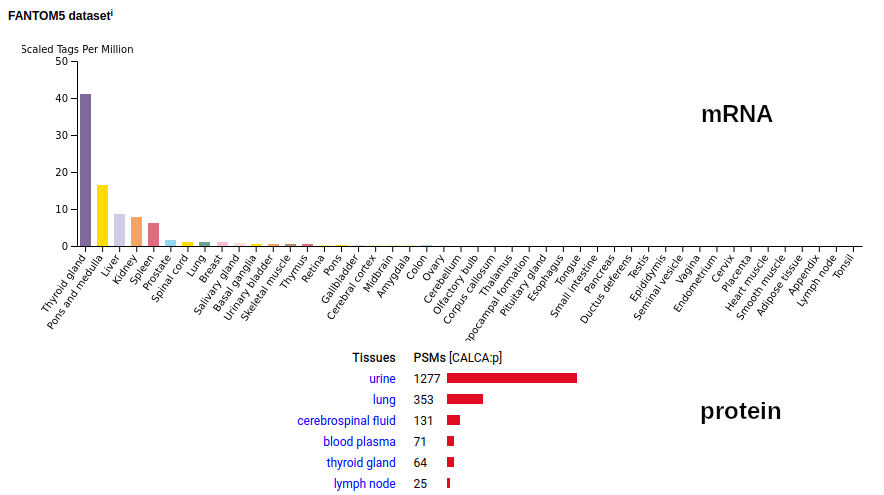
TG:p (thyroglobulin) is the crazy uncle amongst the peptide hormone precursors. It is a huge bear of a glycoprotein (20-2768) that is A1 on the jukebox in any thyroid gland proteomics experiment. It is used to make multiple thyroxine molecules out of pairs of diiodo-tyrosine residues that have been baked in place by a complicated process. TG:p has more than 20 observed high occupancy iodo-tyrosine acceptors, including a mix of mono-, di- & tri-iodo residues at each site. 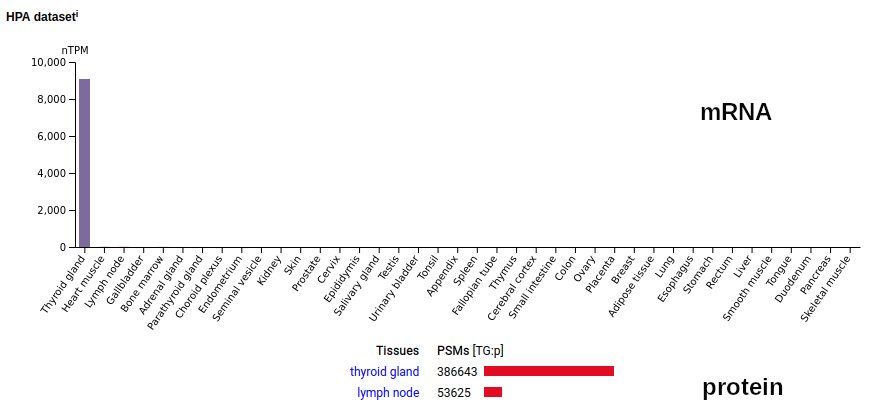
RETN:p, resistin is a teensy-weensy human protein presumed hormone (19-108) found in extracellular vesicles shed mainly by monocyte-lineage leukocytes (particularly neutrophils). The 'zine/grants complex consensus approach has really messed up documenting what is known about this one: DB/AI blurbs on the subject make for rather sad reading. 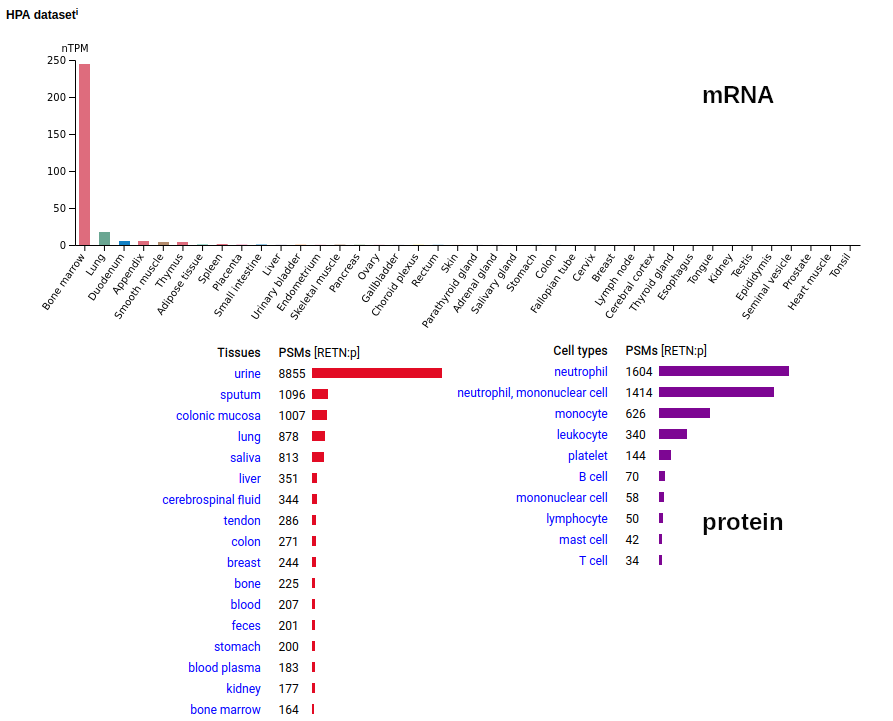
ADIPOQ:p (adiponectin, C1Q and collagen domain containing) is on the chunky side for a protein hormone (19-244). It is secreted by white adipose tissue. The combination of its relatively large size & its high concentration in blood (3—30 μg/ml) makes it one of the few peptide hormones that is commonly observed in proteomics experiments. 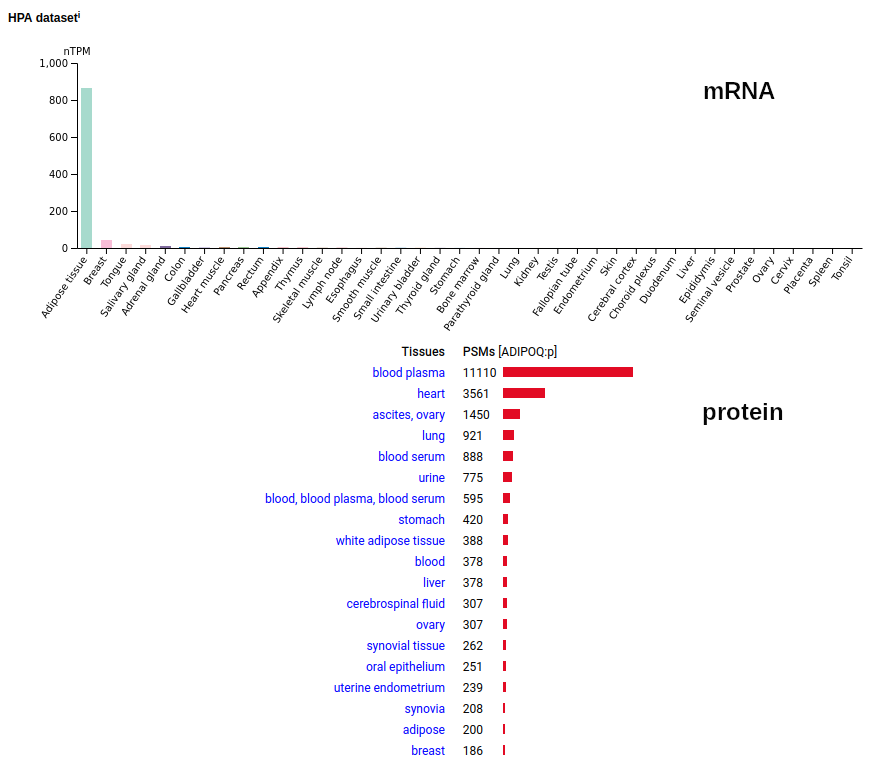
LEP:p (leptin) is a nerdy little protein hormone (22-167) that is secreted by adipose cells and ends up in blood plasma. The circulating plasma level of the hormone (0.5—15 ng/ml) signals the level of adipose triglyceride reserves to the rest of the body, where a low leptin level means low triglyceride stores. Despite a lot of effort, leptin (& its receptor) proved impractical to use therapeutically for weight loss. 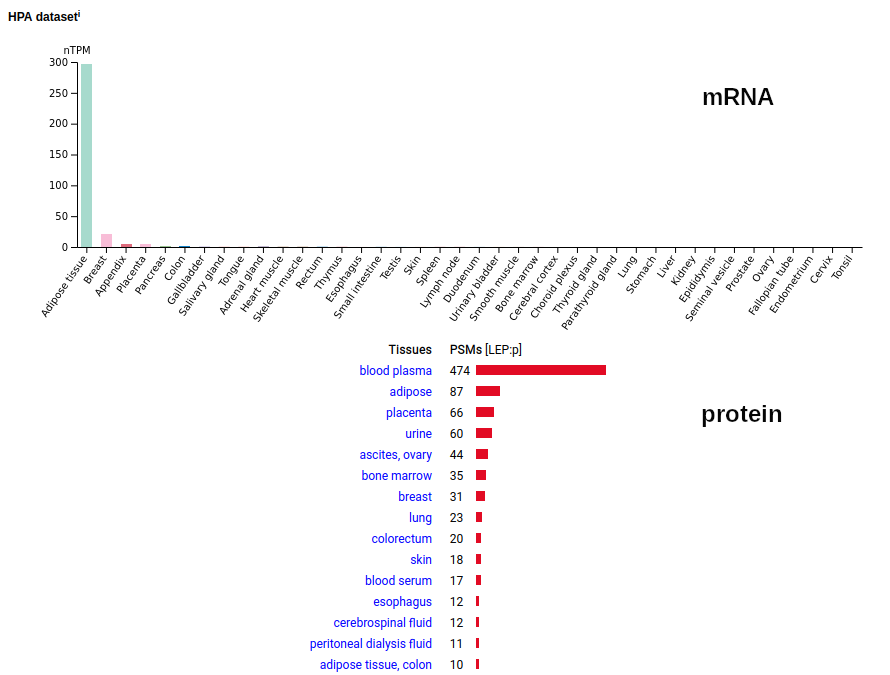
PRL:p (prolactin) is a pint-sized protein with a ragged N-terminus (26,29-227) that is secreted whole by the pituitary gland. In adults, its primary function is to stimulate the secretion of milk. In the fetus, it is believed to be secreted by the fetal pituitary, but its function is unknown. The intact hormone is observed in CSF, blood plasma & urine in adults and fetal amniotic fluid. 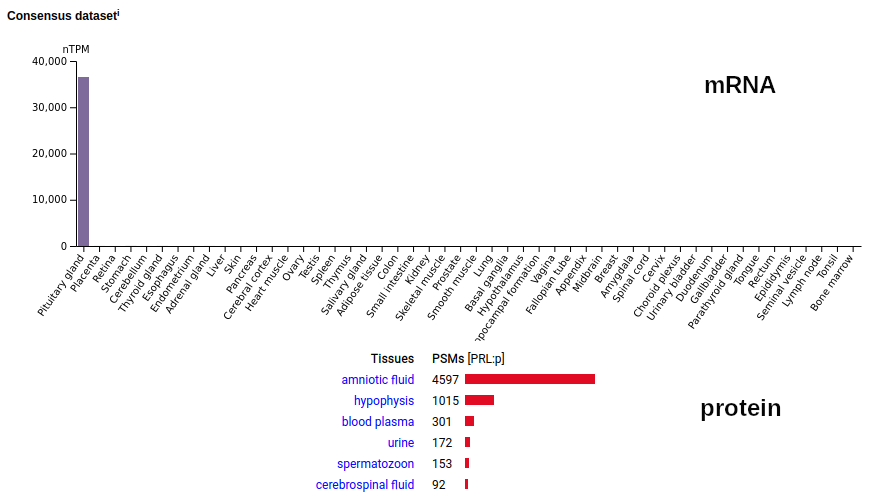
TSHB:p (thyroid stimulating hormone, beta) produces a fly-weight subunit (21-238) that dimerizes with CGA:p to form active hormone thyrotropin. It is a hormone that governs the release of other hormones from the thyroid, which in turn set the levels for many organism-wide metabolic processes. This little fellow isn't detectable in urine or blood plasma. 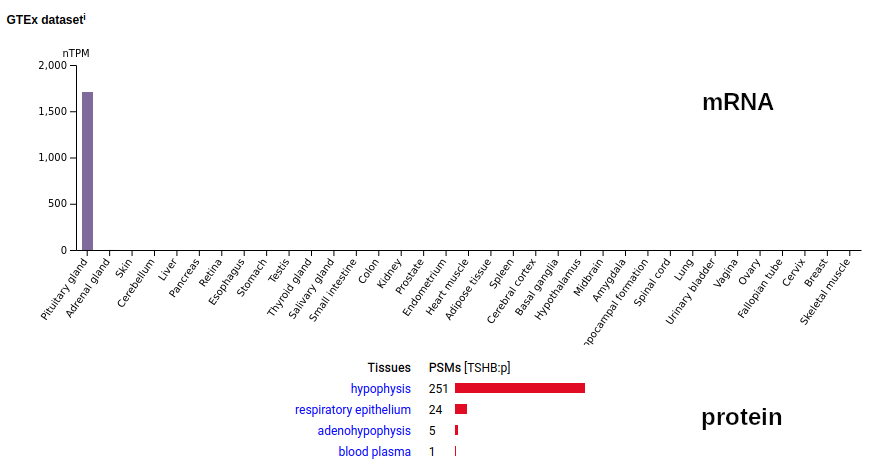
FSHB:p (follicle stimulating hormone subunit beta) is a small glycosylated subunit (21-129) that dimerizes with CGA:p to produce active follicle stimulating hormone. Its presence in urine is the basis for a number of clinical & home test kits for menopause & fertility. It is observable in the urine of both sexes. 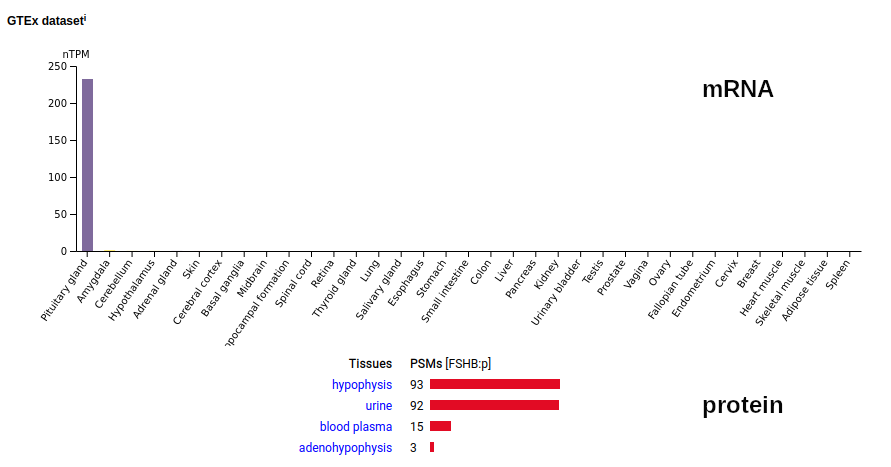
CGB3:p (chorionic gonadotropin subunit beta 3) is one of 6 genes in a cluster on chromosome 19 for nearly identical tiny subunits (21-165) that are made in the placenta and dimerize with CGA:p to form the active hormone chorionic gonadotropin. This hormone shares the same receptor as luteinizing hormone & it is specific to primates. 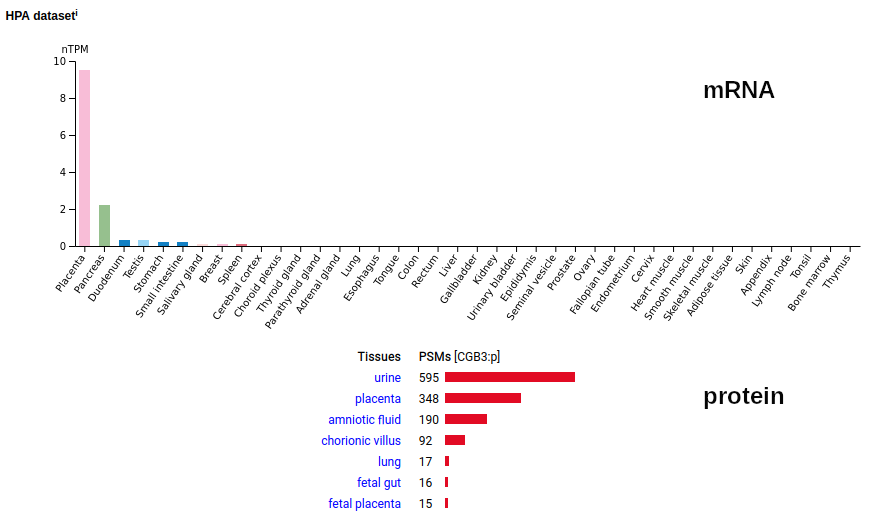
LHB:p (luteinizing hormone subunit beta) is a measly little protein (21-141) made in the pituitary gland that dimerizes with CGA:p to form mature luteinizing hormone that is secreted to target the testes & ovaries. 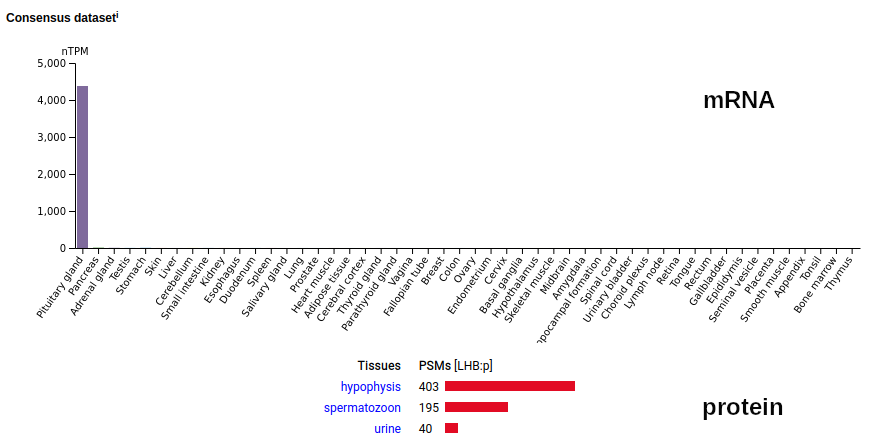
AGT:p (angiotensinogen) is a whopper of a proprotein (25-485) that is secreted by the liver and the CNS. One of either Angiotensin 1 (25-34), 2 (25-32), 3 (26-32) or 4 (27-32) is cleaved off the N-terminus of the protein. The remnant without angiotensin (34-485) is also secreted into blood plasma & CSF; it is prominently observed in proteomics experiments. 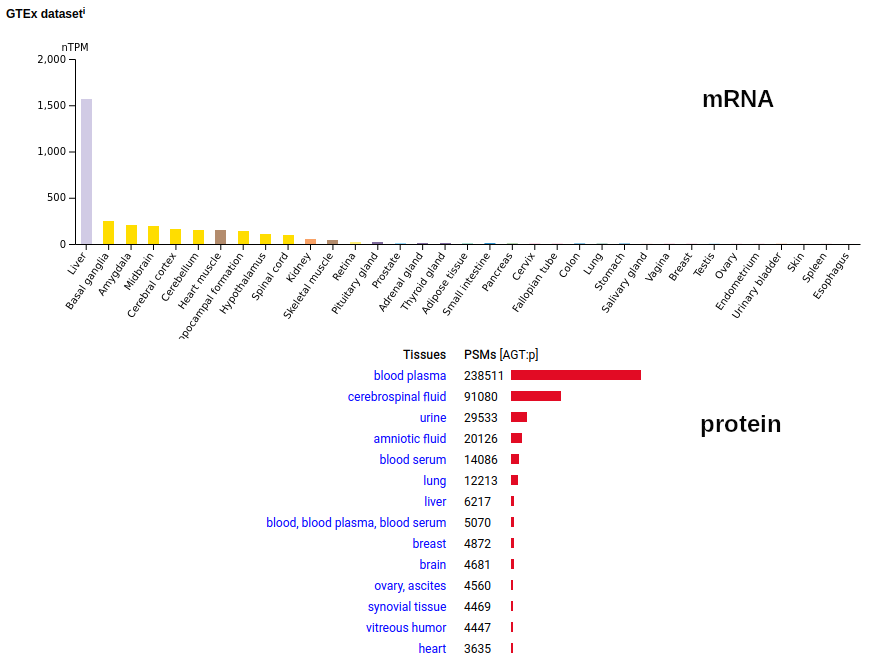
POMC:p (proopiomelanocortin) generates a small proprotein (26-267) that serves as a cornucopia of peptide hormones. It is primarily made in the pituitary gland & exported to the hypophysis for processing & secretion. The hormones sourced from this proprotein include: Melanotropin γ, Melanocyte-stimulating hormone α, Corticotropin, Corticotropin-like intermediary peptide, Lipotropins β & γ, Melanocyte-stimulating hormone β, Leucine enkephalin and β-Endorphin. 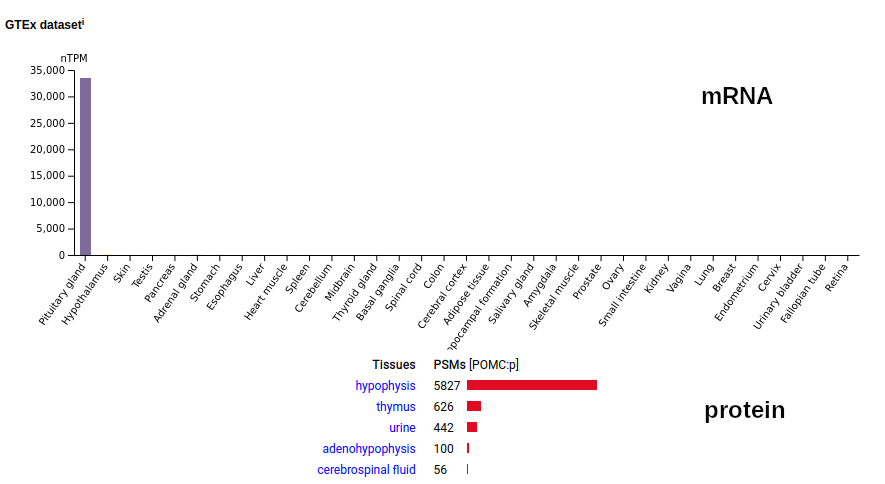
PDYN:p (prodynorphin) is a little friendly stranger that packs a wallop in the pain department. It is cleaved up by PCSK2:p to make Dynorphin A, 3 copies of Leu-enkephalin, α- & β-Neoendorphin, Rimorphin & Leumorphin. The CSF protein observations correspond to the inert propeptide (26-173). There is no trace of it in the urine. 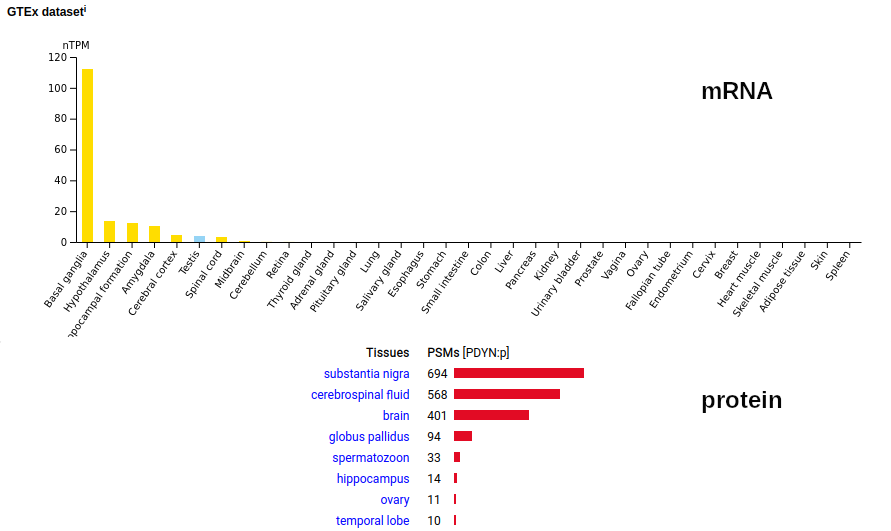
PENK:p (proenkephalin) codes for a relatively chunky proprotein (25-267) that contains multiple copies of the opioid receptor binding 5 residue neuropeptides Met-enkephalin & one copy of Leu-enkephalin. The proprotein is primarily secreted intact by the basal ganglia's medium spiny neurons into the CSF for processing elsewhere. 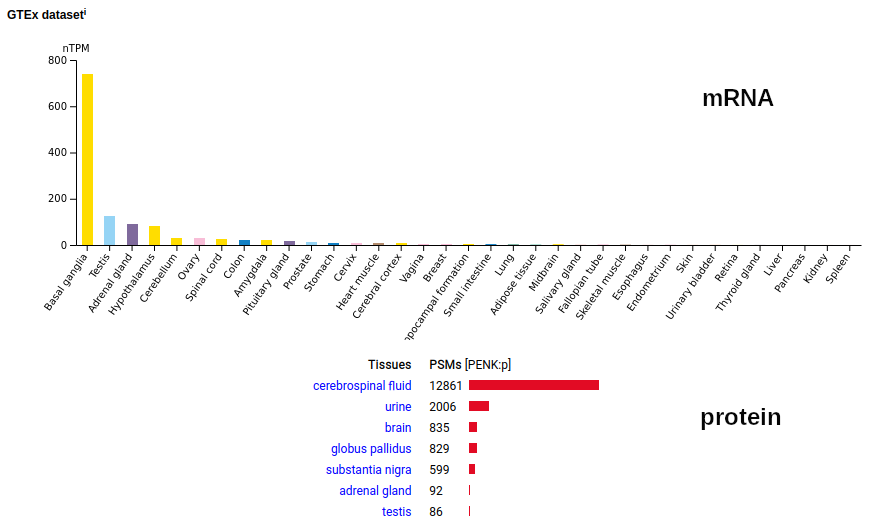
AVP:p (arginine vasopressin) is used to make a bijou proprotein (20-169) in the hypothalamus that is transported down nerve axons into the nearby hypophysis where secretion occurs. The hypophysis is also where it is carved up into the hormones arginine vasopressin (20-28) & neurophysin 2 (32-124), as well as the inert biomarker glycopeptide copeptin (126-164). Copeptin is frequently observed in its deglycosylated form, which causes the deamidation of N131. 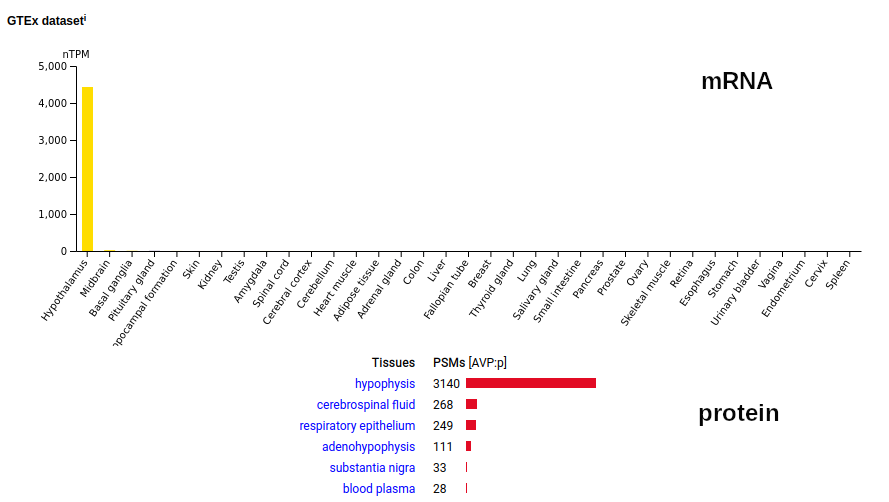
TAC1:p (tachykinin precursor 1) is a dinky little proprotein (20-119) that is processed to produce Substance P (58-68), Neuropeptide K (72-107) & Neurokinin A (98-107). 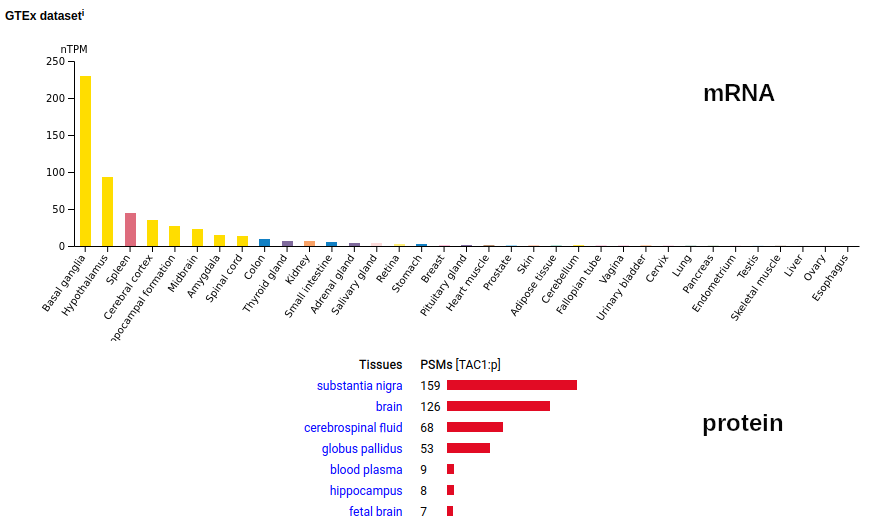
OXT:p (oxytocin/neurophysin I prepropeptide) makes a puny little proprotein (20-125) in the hypophysis/pituitary gland that is cleaved up into the peptide hormones oxytocin (20-28) & neurophysin 1 (32-125). 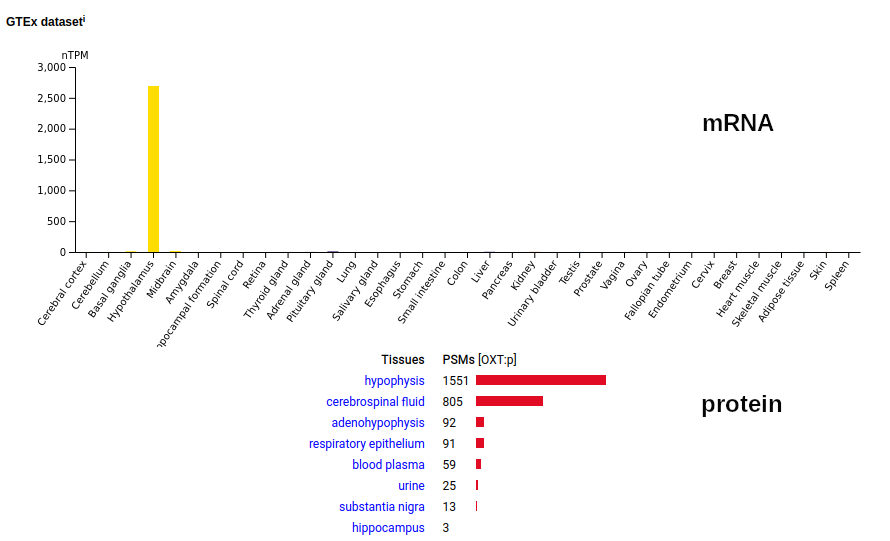
IAPP:p (islet amyloid polypeptide) is a little pixie of a proprotein, corresponding to (23-89) of the translated sequence after the loss of the N-terminal signal peptide. It gets cut up further to create the eponymous active peptide hormone (34-70). This proprotein is made in the same pancreatic β cells that produce insulin & the hormone form is secreted in the same granules as its more famous cell mate. 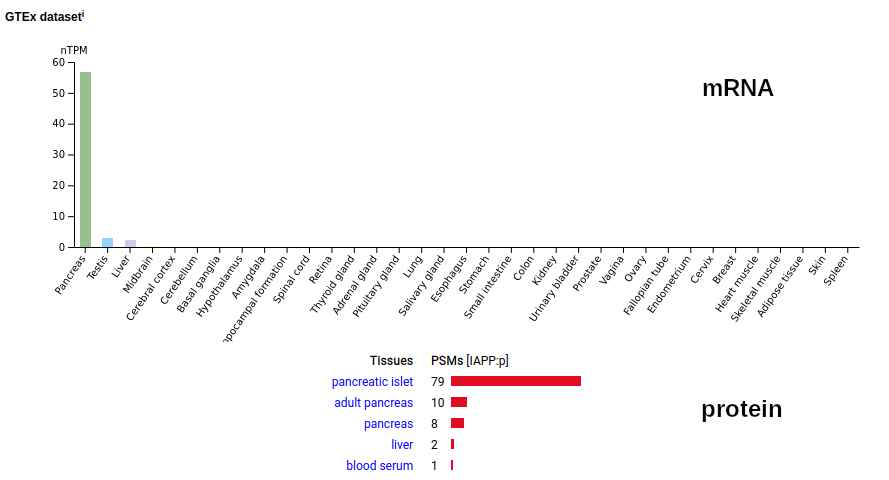
VIP:p (vasoactive intestinal peptide) proprotein is just a little wisp of a thing that can be found in the intestines and the brain, where it is cut to make the peptide hormone for which it is named (125-152). 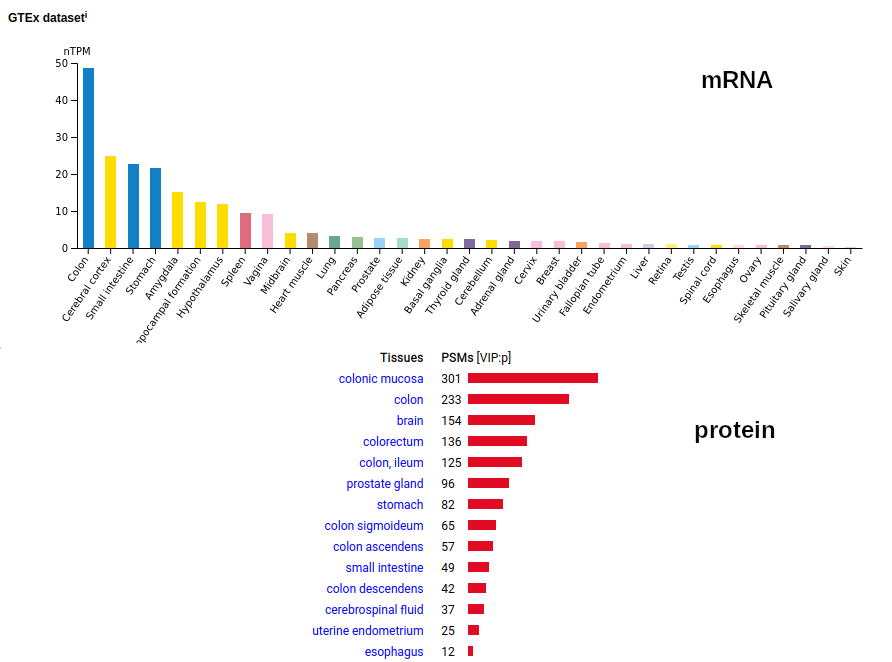
The stomach produces the so-small protein GAST:p (progastrin, 22-101) that is chopped up to make the active peptide gastrin (76-92), as well as gastrin-6, gastrin-14, gastrin-52, gastrin-71 & big gastrin. These signal the pancreas to release digestive enzymes and the stomach to secrete HCl and firm up its protective mucus layer. 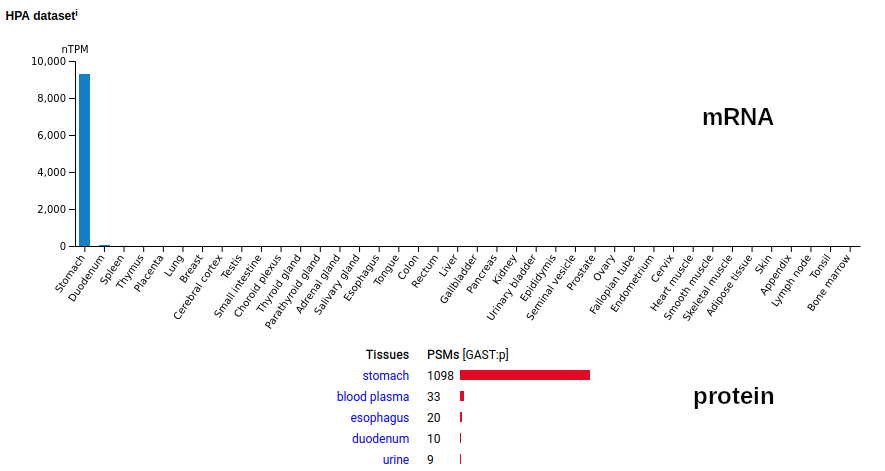
CCK:p (cholecystokinin) is an easily missed, very small proprotein that can be carved up into peptides that regulate bile secretion in the gut & the feeling of fear in the CNS. 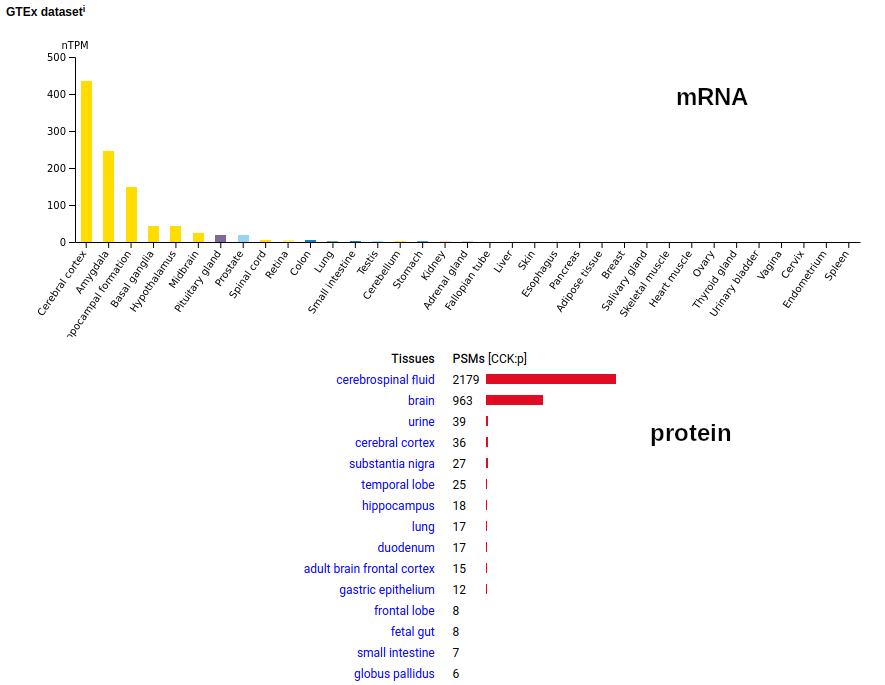
PPY:p (pancreatic polypeptide) is a teens-weensy protein that is translated in pancreatic γ cells, the rarest the Islet of Langerhans named secretory cells types. The active hormone (also called pancreatic polypeptide) is made by a cleaving the proprotein at Y65-G66 to form (30-65). A lot of research has yielded quite a bit of phenomenology wrt to the hormone's function. 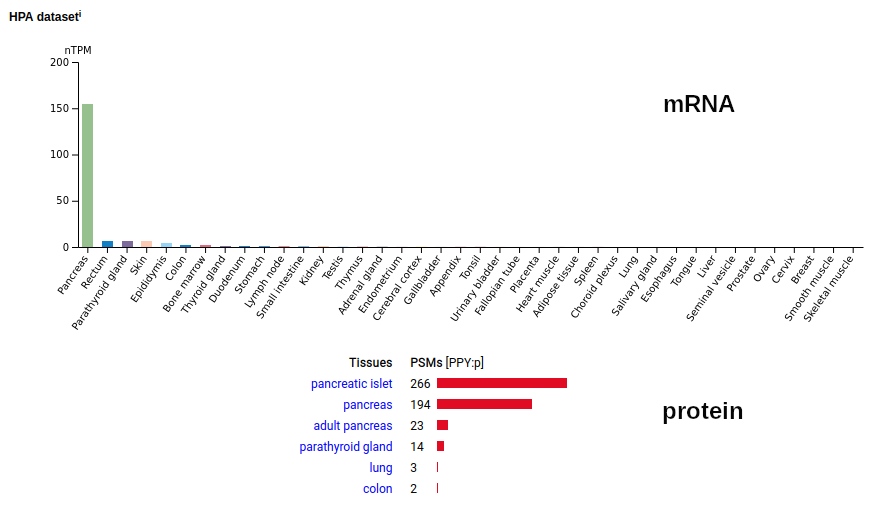
SST (somatostatin) makes an itty-bitty protein that is translated in pancreatic δ cells & cleaved into two hormones: (89-116) somatostatin-28 or (103-116) somatostatin-14. It is also made by cells in the stomach, other parts of the GI system & the brain. Where ever it shows up, it suppresses the release of other peptide hormones, e.g. insulin, glucagon & somatotrophin. Best observed when not using FASP. 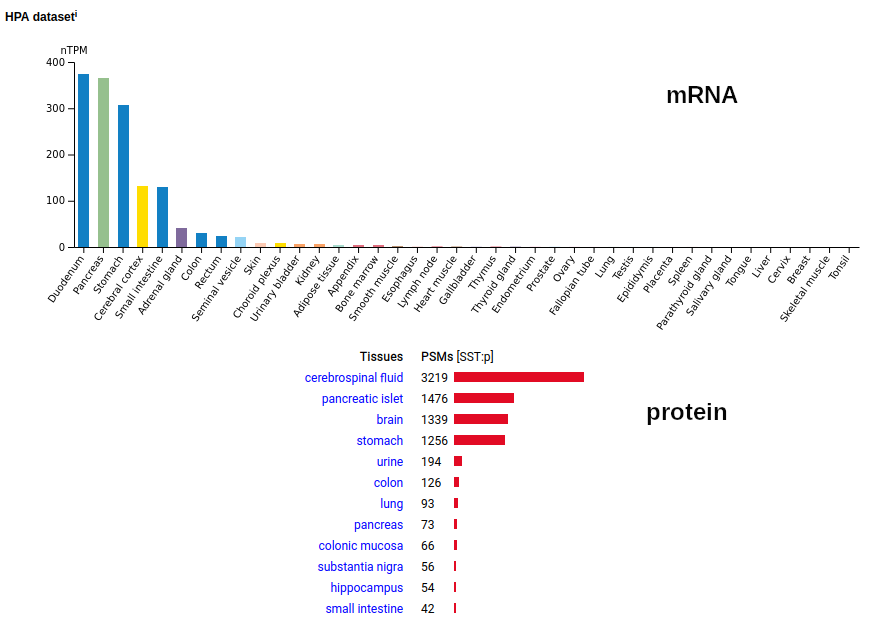
Pancreatic α-cells & intestinal L-cells make proglucagon, which is further cleaved into FASP-discarded, overlapping bioactive peptides: 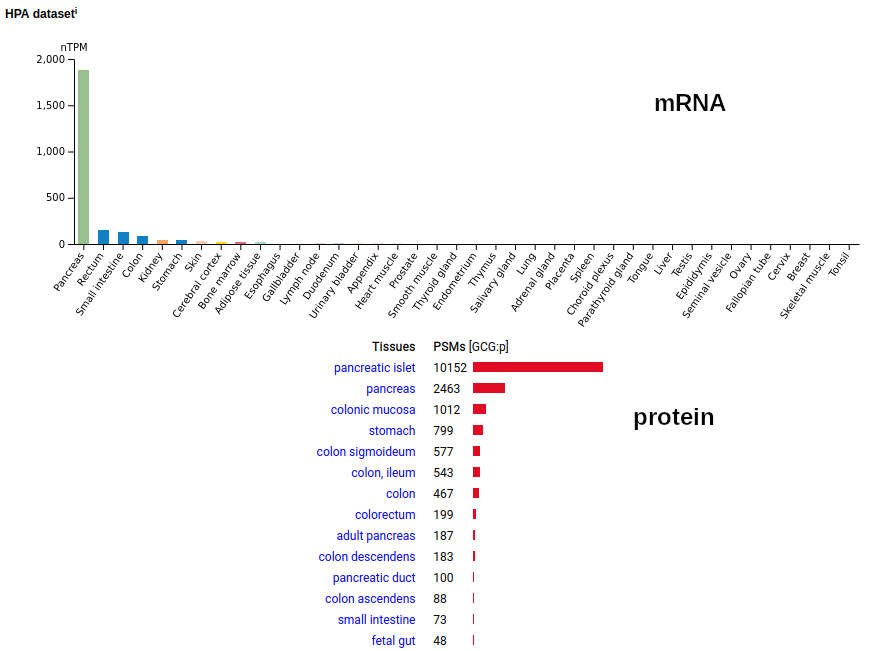
The near-complete adoption of FASP makes small proteins difficult to observe in many proteomics data sets, but human INS (insulin) can be seen in some tissues. Observations in urine correspond to insulin's C peptide only; proinsulin dominates in the pancreas. 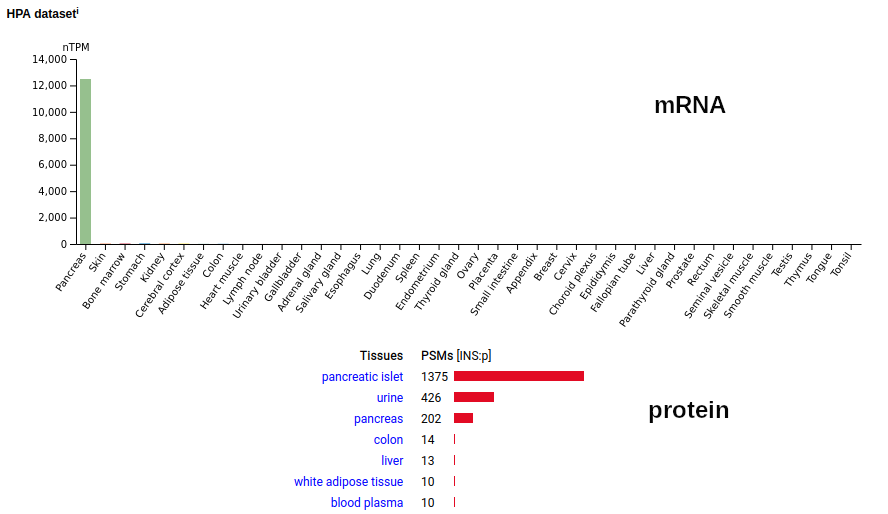
Copyright © 2024, The Global Proteome Machine.
|